Yamaha HTR-5630RDS User Manual

GB
HTR-5630RDS
AV Receiver
Ampli-tuner audio-vidéo
OWNER’S MANUAL MODE D’EMPLOI BEDIENUNGSANLEITUNG BRUKSANVISNING MANUALE DI ISTRUZIONI
MANUAL DE INSTRUCCIONES GEBRUIKSAANWIJZING
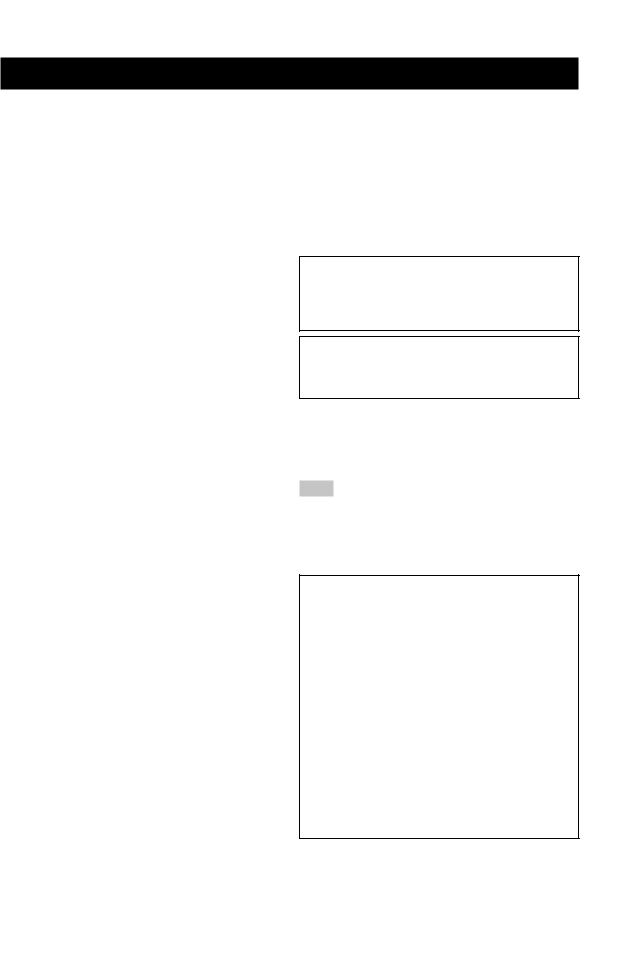
CAUTION: READ THIS BEFORE OPERATING YOUR UNIT.
1To assure the finest performance, please read this manual carefully. Keep it in a safe place for future reference.
2Install this sound system in a well ventilated, cool, dry, clean place — away from direct sunlight, heat sources, vibration, dust, moisture, and/or cold.
Allow ventilation space of at least 30 cm on the top, 20 cm on the left and right, and 20 cm on the back of this unit.
3Locate this unit away from other electrical appliances, motors, or transformers to avoid humming sounds.
4Do not expose this unit to sudden temperature changes from cold to hot, and do not locate this unit in a environment with high humidity (i.e. a room with a humidifier) to prevent condensation inside this unit, which may cause an electrical shock, fire, damage to this unit, and/or personal injury.
5Avoid installing this unit where foreign object may fall onto this unit and/or this unit may be exposed to liquid dripping or splashing. On the top of this unit, do not place:
–Other components, as they may cause damage and/or discoloration on the surface of this unit.
–Burning objects (i.e. candles), as they may cause fire, damage to this unit, and/or personal injury.
–Containers with liquid in them, as they may fall and liquid may cause electrical shock to the user and/or damage to this unit.
6Do not cover this unit with a newspaper, tablecloth, curtain, etc. in order not to obstruct heat radiation. If the temperature inside this unit rises, it may cause fire, damage to this unit, and/or personal injury.
7Do not plug in this unit to a wall outlet until all connections are complete.
8Do not operate this unit upside-down. It may overheat, possibly causing damage.
9Do not use force on switches, knobs and/or cords.
10When disconnecting the power cord from the wall outlet, grasp the plug; do not pull the cord.
11Do not clean this unit with chemical solvents; this might damage the finish. Use a clean, dry cloth.
12Only voltage specified on this unit must be used. Using this unit with a higher voltage than specified is dangerous and may cause fire, damage to this unit, and/or personal injury.YAMAHA will not be held responsible for any damage resulting from use of this unit with a voltage other than specified.
13To prevent damage by lightning, disconnect the power cord from the wall outlet during an electrical storm.
14Do not attempt to modify or fix this unit. Contact qualified YAMAHA service personnel when any service is needed. The cabinet should never be opened for any reasons.
15When not planning to use this unit for long periods of time (i.e. vacation), disconnect the AC power plug from the wall outlet.
16Be sure to read the “TROUBLESHOOTING” section on common operating errors before concluding that this unit is faulty.
17Before moving this unit, press STANDBY/ON to set this unit in standby mode, and disconnect the AC power plug from the wall outlet.
18VOLTAGE SELECTOR (General model only)
The VOLTAGE SELECTOR on the rear panel of this unit must be set for your local main voltage BEFORE plugging into the AC main supply. Voltages are 110V-120V, 220V-240V AC, 50/60 Hz.
This unit is not disconnected from the AC power source as long as it is connected to the wall outlet, even if this unit itself is turned off. This state is called standby mode. In this state, this unit is designed to consume a very small quantity of power.
WARNING
TO REDUCE THE RISK OF FIRE OR ELECTRIC SHOCK, DO NOT EXPOSE THIS UNIT TO RAIN OR MOISTURE.
■ For U.K. customers
If the socket outlets in the home are not suitable for the plug supplied with this appliance, it should be cut off and an appropriate 3 pin plug fitted. For details, refer to the instructions described below.
Note
•The plug severed from the mains lead must be destroyed, as a plug with bared flexible cord is hazardous if engaged in a live socket outlet.
■ Special Instructions for U.K. Model
IMPORTANT
THE WIRES IN MAINS LEAD ARE COLOURED IN ACCORDANCE WITH THE FOLLOWING CODE:
Blue: NEUTRAL
Brown: LIVE
As the colours of the wires in the mains lead of this apparatus may not correspond with the coloured markings identifying the terminals in your plug, proceed as follows:
The wire which is coloured BLUE must be connected to the terminal which is marked with the letter N or coloured BLACK. The wire which is coloured BROWN must be connected to the terminal which is marked with the letter L or coloured RED.
Making sure that neither core is connected to the earth terminal of the three pin plug.
CAUTION

CONTENTS
INTRODUCTION |
|
CONTENTS ............................................................ |
1 |
FEATURES ............................................................. |
2 |
GETTING STARTED ............................................ |
3 |
Supplied accessories .................................................. |
3 |
Installing batteries in the remote control ................... |
3 |
CONTROLS AND FUNCTIONS ......................... |
4 |
Front panel ................................................................. |
4 |
Remote control .......................................................... |
6 |
Front panel display .................................................... |
8 |
PREPARATION |
|
CONNECTIONS .................................................... |
9 |
Before connecting components ................................. |
9 |
Connecting video components ................................ |
10 |
Connecting audio components ................................ |
11 |
Connecting the antennas .......................................... |
12 |
Connecting an external decoder .............................. |
13 |
Connecting the speakers .......................................... |
14 |
Connecting the power supply cords ........................ |
17 |
Turning on the power .............................................. |
17 |
BASIC SYSTEM SETTINGS ............................. |
18 |
Using the basic menu .............................................. |
18 |
Setting the unit to match your speaker system ........ |
20 |
Setting speaker output levels (SP LEVEL) ............. |
20 |
BASIC OPERATION |
|
PLAYBACK .......................................................... |
21 |
Input modes and indications .................................... |
23 |
Selecting a sound field program .............................. |
24 |
DIGITAL SOUND FIELD PROCESSING (DSP) |
|
............................................................................ |
27 |
Understanding sound fields ..................................... |
27 |
Hi-Fi DSP programs ................................................ |
27 |
CINEMA-DSP ...................................................... |
28 |
Sound design of CINEMA-DSP ............................. |
28 |
CINEMA-DSP Programs ........................................ |
28 |
Sound field effects ................................................... |
30 |
TUNING ................................................................ |
31 |
Presetting stations .................................................... |
32 |
Selecting a preset station ......................................... |
34 |
RECEIVING RDS STATIONS ........................... |
35 |
Description of RDS data ......................................... |
35 |
Changing the RDS mode ......................................... |
35 |
PTY SEEK function ................................................ |
36 |
EON function .......................................................... |
36 |
SLEEP TIMER ..................................................... |
37 |
RECORDING ....................................................... |
38 |
ADVANCED OPERATION |
|
SET MENU ........................................................... |
39 |
Set menu list ............................................................ |
39 |
Adjusting the items on the set menu ....................... |
39 |
SOUND 1 SPEAKER SET (speaker mode settings) |
|
............................................................................. |
40 |
SOUND 2 SP DISTANCE (speaker distance) ........ |
42 |
SOUND 3 LFE LEVEL .......................................... |
42 |
SOUND 4 D. RANGE (dynamic range) ................. |
42 |
SOUND 5 CENTER GEQ |
|
(center graphic equalizer) .................................... |
43 |
SOUND 6 HP TONE CTRL |
|
(headphone tone control) .................................... |
43 |
INPUT 1 I/O ASSIGN (input/output assignment) .. |
43 |
INPUT 2 INPUT MODE (initial input mode) ........ |
43 |
OPTION 1 DISPLAY SET ...................................... |
44 |
OPTION 2 MEM. GUARD (memory guard) ......... |
44 |
OPTION 3 AUDIO MUTE ..................................... |
44 |
SETTING THE SPEAKER LEVELS ................ |
45 |
Adjusting the volume during playback ................... |
45 |
Using the test tone ................................................... |
45 |
ADDITIONAL INFORMATION |
|
SOUND FIELD PROGRAM PARAMETER |
|
EDITING .......................................................... |
46 |
Changing parameter settings ................................... |
46 |
Digital sound field parameter descriptions .............. |
47 |
TROUBLESHOOTING ....................................... |
48 |
GLOSSARY .......................................................... |
52 |
SPECIFICATIONS .............................................. |
54 |
INTRODUCTION |
|
|
|
|
|
PREPARATION |
|
|
|
|
|
OPERATION |
BASIC |
|
|
|
|
OPERATION |
ADVANCED |
|
|
|
|
INFORMATION |
ADDITIONAL |
|
|
English
1

|
|
FEATURES |
Built-in 5-channel power amplifier |
Multi-mode digital sound field processing |
|
Minimum RMS output power |
Dolby Pro Logic/Dolby Pro Logic II decoder |
|
(0.1% THD, 1 kHz, 6Ω) |
Dolby Digital/Dolby Digital + Matrix 6.1 Decoder |
|
[U.S.A. and Canada models] |
DTS/DTS + Matrix 6.1 Decoder |
|
Main: |
70 W + 70 W |
CINEMA DSP: Combination of YAMAHA DSP |
Center: |
70 W |
technology and Dolby Pro Logic, Dolby Digital or |
Rear: |
70 W + 70 W |
DTS |
[Other models] |
|
Virtual CINEMA DSP |
Main: |
60 W + 60 W |
SILENT CINEMA DSP |
Center: |
60 W |
Sophisticated AM/FM Tuner |
Rear: |
60 W + 60 W |
|
|
|
40-Station random access preset tuning |
|
|
Automatic preset tuning |
|
|
Preset station shifting capability (Preset editing) |
Other features
96 kHz/24-bit D/A converter
Set menu for optimizing this unit for your Audio/ Video system
Test tone generator for easier speaker balance adjustment
6-channel external decoder input
Optical and coaxial digital audio signal jacksSleep timer
■ About this manual
•yindicates a tip for your operation.
•Some operations can be performed by using either the buttons on the main unit or on the remote control. In cases when the button names differ between the main unit and the remote control, the button name on the remote control is given in parentheses.
•This manual is printed prior to production. Design and specifications are subject to change in part for the reason of the improvement in operativity ability, and others. In this case, the product has priority.
Manufactured under license from Dolby Laboratories.
“Dolby”, “Pro Logic”, and the double-D symbol are trademarks of Dolby Laboratories.
“DTS” and “DTS Digital Surround” are registered trademarks of Digital Theater Systems, Inc.
2
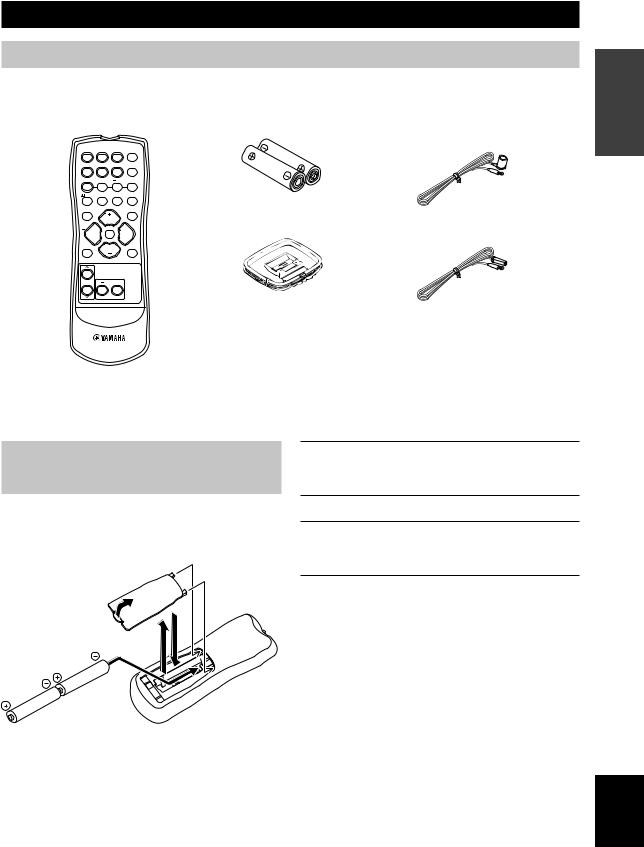
GETTING STARTED
Supplied accessories
After unpacking, check that the following parts are contained.
Remote control |
Batteries (2) |
Indoor FM antenna |
||
|
|
|
(AA, R06, UM-3) |
(U.S.A., Canada, China, |
|
|
|
|
Korea and General models) |
DVD D-TV/CBL VCR |
POWER |
|
|
|
CD MD/CD-R V-AUX |
6CH IN |
|
|
|
TUNER A/B/C/D/E |
PRESET |
|
|
|
/DTS 6.1/5.1 |
NIGHT |
SLEEP |
|
|
TEST |
|
STEREO |
AM loop antenna |
(Europe, U.K., Australia and |
VOLUME |
|
|||
PROG |
|
PROG |
|
Singapore models) |
MUTE |
|
|
||
LEVEL |
|
SET MENU |
|
|
VOLUME |
|
|
|
|
INTRODUCTION
Installing batteries in the remote
control
Insert the batteries in the correct direction by aligning the + and – marks on the batteries with the polarity markings (+ and –) inside the battery compartment.
1
4
2
3
1 Press the tab of the battery compartment cover and pull it in the direction of the arrow to open the cover.
2 Remove the cover.
3 Insert the two batteries supplied (AA, R06,
UM-3) according to the polarity markings on the inside of the battery compartment.
4 Put the cover back into place.
■ Notes on batteries
•Change all of the batteries if you notice a decrease in the operating range of the remote control.
•Do not use old batteries together with new ones.
•Do not use different types of batteries (such as alkaline and manganese batteries) together. Read the packaging carefully as these different types of batteries may have the same shape and color.
•If the batteries have leaked, dispose of them immediately. Avoid touching the leaked material or letting it come into contact with clothing, etc. Clean the battery compartment thoroughly before installing new batteries.
English
3
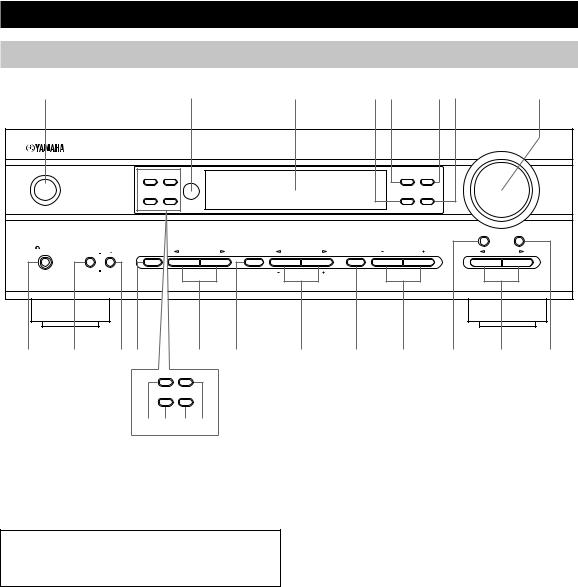
CONTROLS AND FUNCTIONS
Front panel
1 |
|
|
|
|
2 |
|
3 |
|
45 |
|
6 7 |
8 |
|
|
|
|
|
|
|
|
|
|
|
VOLUME |
|
|
|
|
RDS MODE/FREQ |
EON |
|
|
|
|
PRESET/TUNING |
FM/AM |
|
|
STANDBY |
|
|
|
|
|
|
|
|
EDIT |
|
|
|
/ON |
|
|
PTY SEEK |
|
|
|
|
TUNING MODE |
|
MEMORY |
|
|
|
|
|
MODE |
START |
|
|
|
|
|
|
||
|
|
|
|
|
|
|
|
|
AUTO/MAN`L MONO |
MAN`L/AUTO FM |
|
|
|
|
|
|
|
|
|
|
|
|
|
INPUT MODE |
6CH INPUT |
SILENT |
SPEAKERS |
STEREO |
|
PROGRAM |
A/B/C/D/E |
PRESET/TUNING |
CONTROL |
BASS/TREBLE |
|
INPUT |
|
|
|
ON |
A |
|
|
|
|||||||
|
OFF |
B |
EFFECT |
|
|
NEXT |
SET MENU |
|
|
|
|
|
PHONES |
|
|
|
|
|
|
|
|
|
|
|
|
9 0 qw |
|
e r |
|
t |
y u i o p |
|||||||
|
|
|
RDS MODE/FREQ |
EON |
|
|
|
|
|
|
|
|
PTY SEEK
MODE START
a s d f
(U.K. and Europe models only)
1 STANDBY/ON
Turns the unit on, or sets it in standby mode. When you turn the unit on, you will hear a click and there will be a 4 to 5-second delay before it can reproduce sound.
Standby mode
In this mode, the unit uses a small amount of power in order to receive infrared-signals from the remote control.
2 Remote control sensor
Receives signals from the remote control.
3 Front panel display
Shows information about the operational status of the unit.
4 TUNING MODE (AUTO/MAN’L MONO)
Switches the tuning mode between automatic and manual.
5 PRESET/TUNING (EDIT)
Switches the function of PRESET/TUNING l/ h between selecting a preset station number and tuning (the colon (:) turns on or off).
This button is also used to exchange the assignment of two preset stations with each other.
6 FM/AM
Switches the reception band between FM and AM.
7 MEMORY (MAN’L/AUTO FM)
Stores the current station in memory.
8 VOLUME
Controls the output level of all audio channels. This does not affect the OUT (REC) level.
9  SILENT (PHONES jack)
SILENT (PHONES jack)
Allows you to enjoy DSP effects when listening with headphones.
Inserting the plug from your headphones into the PHONES jack does not affect the sound output from the speakers. If you wish to stop the signal output to the speakers, press SPEAKERS ON/OFF so that it is in the OFF position.
0 SPEAKERS ON/OFF
Turns on or off the speakers that you selected by SPEAKERS A/B.
q SPEAKERS A/B
Selects the set of main speakers connected to the A or B terminals.
4
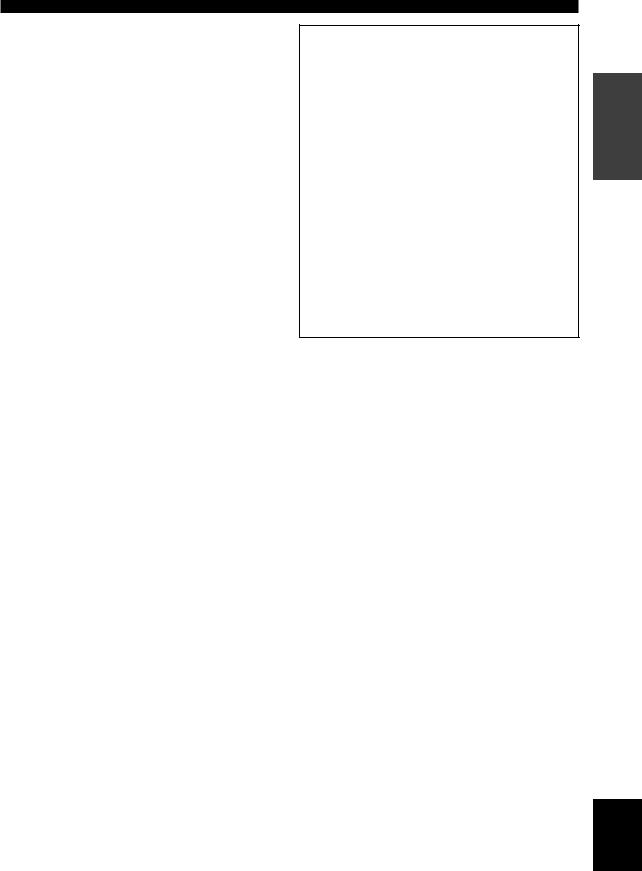
w STEREO (EFFECT)
Switches between normal stereo and DSP effect reproduction. When you select STEREO, the unit mixes down all Dolby Digital and DTS signals (except the LFE channel) as well as those 2-channel signals without effects, to the main left and right speakers.
e PROGRAM l / h
Select the DSP program.
r A/B/C/D/E
Selects preset station groups A to E when the unit is in tuner mode.
NEXT
Selects the set menu mode when the unit is not in tuner mode.
t PRESET/TUNING l/ h
Select preset station numbers 1 to 8 when a colon (:) is displayed in the front panel display.
Select the tuning frequency when a colon (:) is not displayed when the unit is in tuner mode.
SET MENU –/+
Adjust settings on the set menu when the unit is not in tuner mode.
y CONTROL
Switches between Bass (low-frequency response) control mode and Treble (high-frequency response) control mode.
u BASS/TREBLE –/+
Increase or decrease low/high-frequency response when the unit is in Bass/Treble control mode. The sound changes 2dB each time you press one of these buttons. Control range: –10 to +10dB.
i INPUT MODE
Sets the priority for the types of input signals (AUTO, DTS, ANALOG) received when one component is connected to two types of input jacks. You cannot set priority for an audio sources if you have selected 6CH INPUT as the input source.
o INPUT l / h
Selects the input source you want to listen to or watch.
p 6CH INPUT
Selects the audio source connected to the 6CH INPUT jacks. This selection takes priority over sources selected with INPUT (or the input selector buttons on the remote control).
CONTROLS AND FUNCTIONS
(U.K. and Europe models only)
a RDS MODE/FREQ
Press this button when the unit is receiving an RDS station, to cycle the display mode among PS mode, PTY mode, RT mode, CT mode (if the station offers those RDS data service) and/or frequency display mode in turn.
s PTY SEEK MODE
Press this button to set the unit in the PTY SEEK mode.
d PTY SEEK START
Press this button to begin searching for a station after the desired program type has been selected in the PTY SEEK mode.
f EON
Press this button to select a radio program type (NEWS, INFO, AFFAIRS, SPORT) to tune in automatically.
INTRODUCTION
English
5
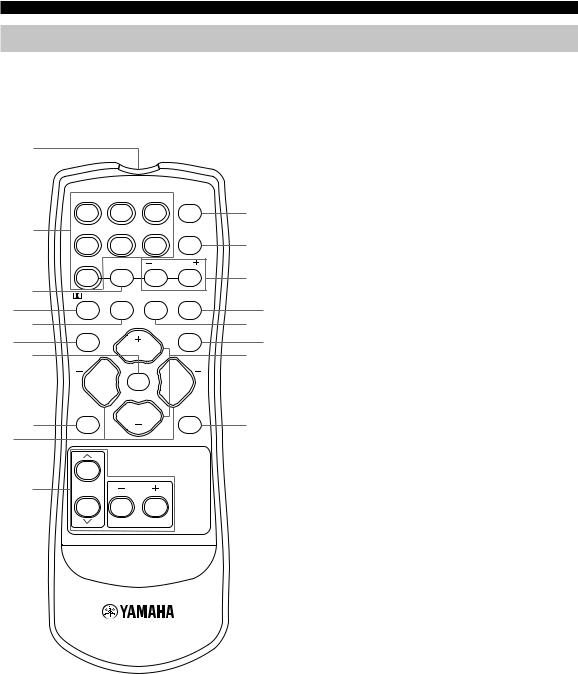
CONTROLS AND FUNCTIONS
Remote control
This section describes the remote control controls and their functions.
1
DVD D-TV/CBL VCR POWER
1 Infrared emitter
Outputs infrared control signals. Aim this emitter at the unit when using the remote control.
2 Input selector buttons
Select the input source.
3 A/B/C/D/E
Selects preset station groups A to E when the unit is in tuner mode.
2
3
4
5
6
7
8
9
0
CD MD/CD-R V-AUX |
6CH IN |
|
TUNER A/B/C/D/E |
PRESET |
|
/DTS 6.1/5.1 |
NIGHT |
SLEEP |
TEST |
|
STEREO |
VOLUME |
|
|
PROG |
|
PROG |
MUTE |
|
|
LEVEL |
|
SET MENU |
VOLUME |
|
|
q4 q/DTS
Selects the built-in Dolby Digital, DTS, Dolby Pro Logic
wor Pro Logic II decoder.
5 6.1/5.1
eSwitches on or off the Dolby Digital + Matrix 6.1 or DTS + Matrix 6.1 decoder.
r
t |
6 TEST |
y |
Outputs a test tone for use when adjusting the speaker |
u |
levels. |
|
|
|
7 MUTE |
|
Mutes the sound. Press again to restore the audio output |
|
to the previous volume level. |
i8 LEVEL
Selects the effect speaker channel to adjust.
9 PROGRAM –/+
Select the DSP program.
0 Multi control section
Used to change and implement settings.
q POWER
Turns the unit on, or sets it in standby mode.
w 6CH IN
Selects the audio source connected to the 6CH INPUT jacks.
e PRESET –/+
Select preset station numbers 1 to 8.
r SLEEP
Sets the sleep timer.
6
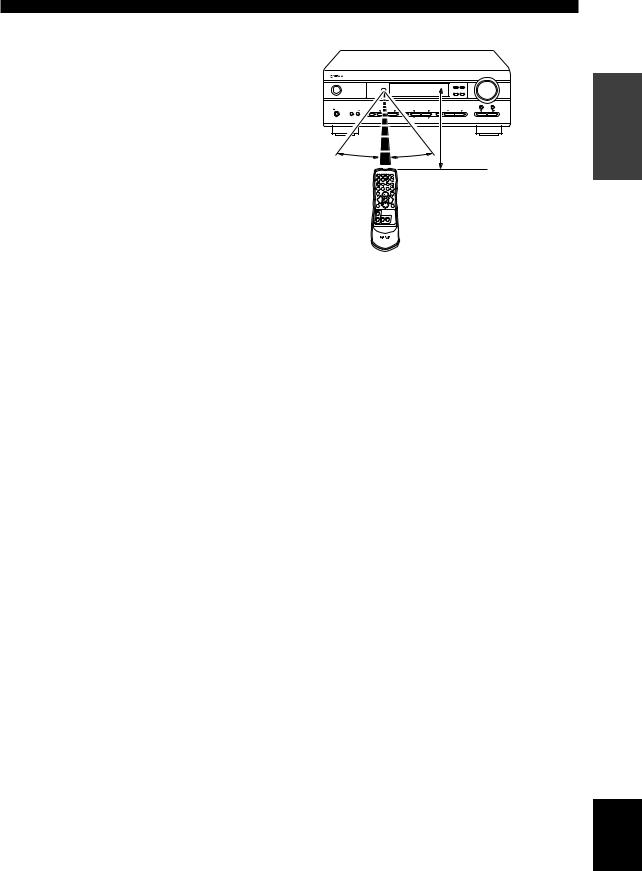
CONTROLS AND FUNCTIONS
t NIGHT |
■ Using the remote control |
Sets the unit in night listening mode.
y STEREO
Switches between normal stereo and DSP effect reproduction. When you select STEREO the unit mixes down all Dolby Digital and DTS signals (except the LFE channel) as well as those 2-channel signals without effect sounds, to the main left and right speakers.
30° |
30° |
Approximately 6 m (20 feet) |
u VOLUME +/– |
|
|
|
|
|
Increases or decreases the volume level. |
|
|
i SET MENU |
|
|
Selects the set menu mode. |
|
|
INTRODUCTION
The remote control transmits a directional infrared beam. Be sure to aim the remote control directly at the remote control sensor on the main unit during operation.
■ Handling the remote control
•Do not spill water or other liquids on the remote control.
•Do not drop the remote control.
•Do not leave or store the remote control in the following types of conditions:
–high humidity or temperature such as near a heater, stove or bath;
–dusty places; or
–in places subject to extremely low temperatures.
English
7
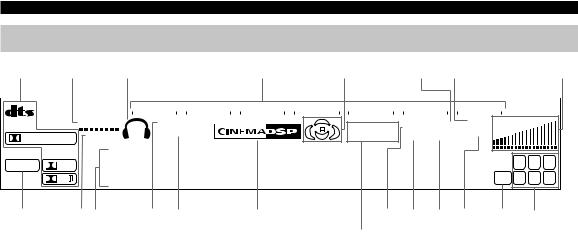
CONTROLS AND FUNCTIONS
Front panel display
1 |
2 |
3 |
|
4 |
5 |
6 |
7 |
8 |
||||||||||
|
|
|
|
|
|
|
|
|
|
|
|
|
||||||
|
|
|
VCR |
|
V-AUX D-TV/CBL |
|
DVD MD/CD-R |
|
TUNER |
|
|
CD |
||||||
|
|
|
|
|
|
|
|
|
|
|
|
|
|
|
|
|
|
|
VIRTUAL NIGHT
MATRIX |
HiFi DSP |
|
DIGITAL SILENT |
||
|
PS PTY RT CT STEREO AUTO EON PTY HOLD TUNED MEMORY
MUTE VOLUME |
SLEEP |
|
~~~~~~~~~~~~~~dB |
L C R |
|
PCM PL |
|
f t |
|
PL |
|
|
LFE RL RC RR |
9 |
0q w e r |
t y u i o p |
|
|
|
a |
|
1 Processor indicators
The indicators for the various decoders light up when the decoders are in use.
2 VIRTUAL indicator
Lights up when using Virtual CINEMA DSP.
3 Headphones indicator
Lights up when headphones are connected to the headphone jack.
4 Input source indicator
Highlights the current input source with a cursor.
5 Sound field indicator
Displays the sound field management the unit is using when you listen to a DSP sound field program.
6 AUTO indicator
Shows that this unit is in the automatic tuning mode.
7 MUTE indicator
Flashes while the MUTE function is on.
8 VOLUME level indicator
Indicates the volume level.
9 PCM indicator
Lights up when this unit is reproducing PCM (pulse code modulation) digital audio signals.
0 SILENT indicator
Lights up when headphones are connected and the digital sound field processor is on.
q Multi-information display
Shows the current DSP program name and other information when you are adjusting or changing settings.
(U.K. and Europe models only)
w NIGHT indicator
Lights up when the unit is set to night listening mode.
e HiFi DSP indicator
Lights up when you select a Hi-Fi DSP sound field program.
r CINEMA DSP indicator
Lights up when you select a CINEMA DSP sound field program.
t STEREO indicator
Lights up when the unit is receiving a strong signal from a FM stereo broadcast while the “AUTO” indicator is lit.
y TUNED indicator
Lights up when this unit is tuned to a radio station.
u MEMORY indicator
Flashes to show a station can be stored in memory.
i SLEEP indicator
Lights up while the sleep timer is on.
o LFE indicator
Lights up when the input signal contains an LFE signal.
p Input channel indicator
The indicators for the appropriate sound channels light up when a digital signal from a source is played back.
a RDS indicator (U.K. and Europe models only)
The name(s) of the RDS data offered by the currently received RDS station light(s) up.
EON indicator lights up when an RDS station that offers the EON data service is being received.
PTY HOLD indicator lights up while searching for stations in the PTY SEEK mode.
8
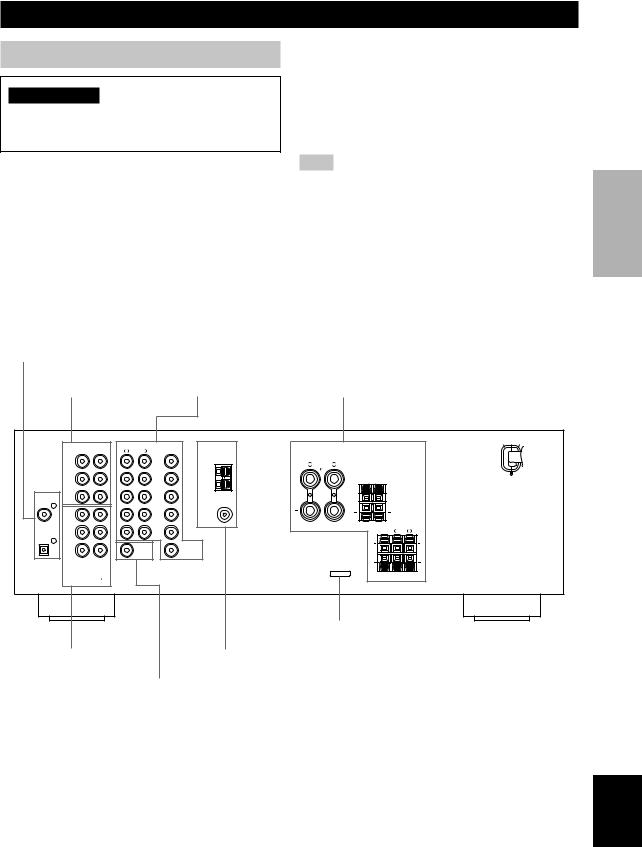
CONNECTIONS
Before connecting components
CAUTION
Do not connect this unit or other components to the mains power until all connections between the components have been completed.
•Be sure all connections are made correctly, that is to say L (left) to L, R (right) to R, “+” to “+” and “–” to “–”. Some components require different connection methods and have different jack names. Refer to the operation instructions for each component you wish to connect to this unit.
•After you have completed all connections, check them again to make sure they are correct.
•The jack names correspond to the names on the input selector.
■ Connecting to digital jacks
This unit has digital jacks for direct transmission of digital signals through either a coaxial or fiber optic cable. You can use the digital jacks to input PCM, Dolby Digital and DTS bitstreams. Use digital connections if you wish to enjoy the multi-channel sound track of DVD material, etc. with DSP effects. Both digital input jacks are acceptable for 96 kHz sampling digital signals.
Note
•The OPTICAL jack on this unit conform to the EIA standard. If you use a fiber optic cable that does not conform to this standard this unit may not function properly.
DIGITAL INPUT jacks (pages 9 – 11)
Audio component jacks |
Video component jacks |
Speaker terminals |
(page 11) |
(page 10) |
(page 16) |
|
AUDIO |
|
AUDIO |
VIDEO |
TUNER |
|
SPEAKERS |
|
|
|
|
|
|
R |
L |
R |
L |
|
|
|
CLASS 2 WIRING |
|
|
|
|
|
CD |
|
|
|
DVD |
|
A |
|
|
|
|
|
|
|
|
|
R |
MAIN |
L |
|
|
|
|
||
|
|
|
|
|
|
|
|
|
|
|||
|
|
|
|
|
|
AM |
|
|
B |
|
|
|
|
|
|
|
|
|
ANT |
|
|
|
|
|
|
|
IN |
|
|
|
D-TV |
|
|
|
|
|
|
|
|
|
|
|
|
|
|
MAIN |
|
|
|
||
|
(PLAY) |
|
|
|
/CBL |
GND |
|
R |
L |
|
|
|
|
MD |
|
|
|
|
|
|
|
|
|
|
|
|
/CD-R |
|
|
|
|
|
|
|
|
|
|
|
DIGITAL |
OUT |
|
|
|
V-AUX |
|
|
|
|
|
|
|
(REC) |
|
|
|
|
|
|
|
|
|
|
||
INPUT |
|
|
|
|
|
75Ω UNBAL. |
|
|
|
|
|
|
CD |
2 |
|
|
|
|
|
|
|
|
|
|
|
|
|
|
|
|
|
|
|
|
|
|
||
|
MAIN |
|
|
|
IN |
FM |
|
|
|
|
|
|
|
|
|
|
|
|
ANT |
|
|
|
|
|
|
|
|
|
|
|
VCR |
|
|
MAIN A OR B : 6Ω MIN./SPEAKER |
|
|
|
REAR |
COAXIAL |
|
|
|
|
|
|
|
|
|
(SURROUND) |
||
OPTICAL |
SURROUND |
|
|
|
OUT |
|
|
|
|
CENTER |
R |
L |
|
|
|
|
|
|
|
|
|
|
|||
DVD |
1 |
|
|
|
|
|
|
|
|
|
|
|
|
|
|
|
SUB |
|
MONITOR |
|
|
|
|
|
|
|
|
|
|
WOOFER |
|
OUT |
|
|
|
|
|
|
|
SUB |
|
|
|
|
|
|
|
|
|
|
|
|
WOOFER |
CENTER |
|
|
|
|
|
|
|
|
|
|
|
|
|
|
|
|
|
|
|
|
CENTER : |
6Ω MIN./SPEAKER |
|
|
6CH INPUT |
OUTPUT |
|
|
|
|
|
REAR : |
6Ω MIN./SPEAKER |
|||
|
|
|
|
|
|
|
|
|
||||
This jack is reserved for factory use.
Do not connect any equipment to this jack.
6CH INPUT jacks |
Antenna input terminals |
(page 13) |
(page 12) |
SUBWOOFER OUTPUT jack (page 16)
PREPARATION
English
9
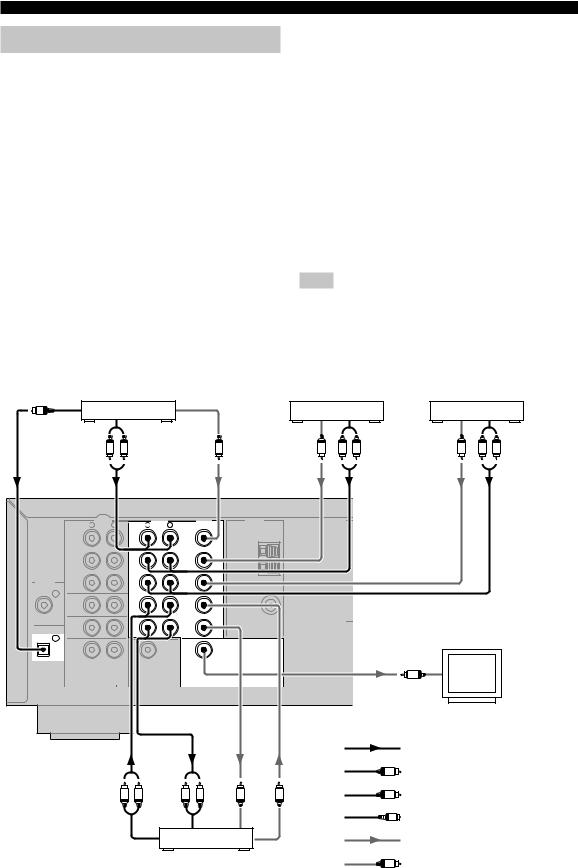
CONNECTIONS
Connecting video components
■ Connecting a video monitor
Connect the video input jack on your video monitor to the MONITOR OUT VIDEO jack.
■ Connecting a DVD player
Connect the optical digital audio signal output jack on your component to the DIGITAL INPUT jack and connect the video signal output jack on the component to the VIDEO jack on this unit.
y
•Use the AUDIO jacks on this unit for a video component which does not have optical digital output jack. However, multi-channel reproduction cannot be obtained with audio signals input from the AUDIO jacks.
■ Connecting a digital TV/cable TV
Connect the video signal output jack on your component to the VIDEO jack on this unit.
Connect the audio signal output jacks on the component to the AUDIO jacks on this unit.
■ Connecting another video component
Connect the video signal output jack on your component to the VIDEO jack on this unit.
Connect the audio signal output jacks on the component to the AUDIO jacks on this unit.
■ Connecting a recording component
Connect the audio signal input jacks on your video component to the AUDIO OUT jacks on this unit. Then connect the video signal input jack on the video component to the VIDEO OUT jack on this unit for picture recording.
Connect the audio signal output jacks on your component to the AUDIO IN jacks on this unit. Then connect the video signal output jack on the component to the VIDEO IN jack on this unit to play a source from your recording component.
Note
•Once you have connected a recording component to this unit, keep its power turned on while using this unit. If the power is off, this unit may distort the sound from other components.
DVD player |
|
TV/digital TV/ |
Another video |
||
|
cable TV |
component |
|
||
O |
|
|
|
|
|
OPTICAL |
|
|
|
|
|
OUTPUT |
VIDEO |
VIDEO |
|
VIDEO |
|
AUDIO |
AUDIO |
AUDIO |
|||
L R OUTPUT |
V OUTPUT |
OUTPUT V |
L R OUTPUT |
OUTPUT V L R |
OUTPUT |
|
AUDIO |
|
AUDIO |
VIDEO |
TUNER |
|
|
|
R |
L |
R |
L |
|
|
|
|
CD |
|
|
|
DVD |
|
|
|
|
|
|
|
|
AM |
|
|
|
|
|
|
|
ANT |
|
|
IN |
|
|
|
D-TV |
|
|
|
(PLAY) |
|
|
|
/CBL |
|
|
|
MD |
|
|
|
|
GND |
|
|
|
|
|
|
|
|
|
|
/CD-R |
|
|
|
|
|
|
DIGITAL |
OUT |
|
|
|
V-AUX |
|
|
(REC) |
|
|
|
|
|
||
INPUT |
|
|
|
|
|
75Ω UNBAL. |
|
CD |
2 |
|
|
|
|
|
|
|
|
|
|
|
|
||
|
MAIN |
|
|
|
IN |
FM |
|
|
|
|
|
ANT |
|
||
|
|
|
|
|
|
|
|
|
|
|
|
|
VCR |
|
|
COAXIAL |
|
|
|
|
|
|
|
OPTICAL |
SURROUND |
|
|
|
OUT |
|
|
DVD |
1 |
|
|
|
|
|
|
|
|
|
|
SUB |
|
MONITOR |
|
|
|
|
|
WOOFER |
|
OUT |
|
|
SUB |
|
|
|
|
|
|
|
WOOFER |
CENTER |
|
|
|
|
|
|
|
|
|
|
|
V |
|
|
6CH INPUT |
OUTPUT |
|
VIDEO |
Video monitor |
||
|
|
|
|
|
|
INPUT |
|
|
|
|
L |
AUDIO |
AUDIO |
VIDEO VIDEO |
|
OUTPUT L |
R INPUT L R |
V INPUT V OUTPUT |
R |
O
VCR |
V |
indicates audio signal direction indicates left analog cables
indicates right analog cables
indicates optical cables indicates video signal direction
indicates video cables
10

Connecting audio components
■ Connecting a CD player
Connect the coaxial digital output jack on your CD player to the DIGITAL INPUT CD jack on this unit.
CONNECTIONS
Note
•Once you have connected a recording component to this unit, keep its power turned on while using this unit. If the power is off, this unit may distort the sound from other components.
y
•Use the AUDIO jacks on this unit to connect to a CD player that does not have a COAXIAL DIGITAL OUTPUT jack, or to record from CD players.
■ Connecting a CD recorder or MD recorder
Connect the input jacks on your CD recorder or MD recorder to the MD/CD-R OUT (REC) jacks. Connect the output jacks on your CD recorder or MD recorder to the MD/CD-R IN (PLAY) jacks to play a source from your recording component.
|
L |
AUDIO |
R |
OUTPUT |
|
CD recorder or
MD recorder
|
L |
AUDIO |
R |
INPUT |
|
|
COAXIAL |
|
CD player |
OUTPUT |
|
C |
||
|
AUDIO
OUTPUT L
R
|
AUDIO |
AUDIO |
VIDEO |
TUNER |
||
|
R |
L |
R |
L |
|
|
|
CD |
|
|
|
DVD |
|
|
|
|
|
|
|
AM |
|
|
|
|
|
|
ANT |
|
IN |
|
|
|
D-TV |
|
|
(PLAY) |
|
|
|
/CBL |
|
|
MD |
|
|
|
|
GND |
|
|
|
|
|
|
|
|
/CD-R |
|
|
|
|
|
DIGITAL |
OUT |
|
|
|
V-AUX |
|
(REC) |
|
|
|
|
||
INPUT |
|
|
|
|
|
75Ω UNBAL. |
CD |
2 |
|
|
|
|
|
|
|
|
|
|
||
|
MAIN |
|
|
|
IN |
FM |
|
|
|
|
ANT |
||
|
|
|
|
|
|
|
|
|
|
|
|
VCR |
|
COAXIAL |
|
|
|
|
|
|
OPTICAL |
SURROUND |
|
|
|
OUT |
|
DVD |
1 |
|
|
|
|
|
|
|
|
|
SUB |
|
MONITOR |
|
|
|
|
WOOFER |
|
OUT |
|
SUB |
|
|
|
|
|
|
WOOFER |
CENTER |
|
|
|
|
|
6CH INPUT |
OUTPUT |
|
|
|
|
|
indicates signal direction |
L |
indicates left analog cables |
R |
indicates right analog cables |
C |
indicates coaxial cables |
PREPARATION
English
11
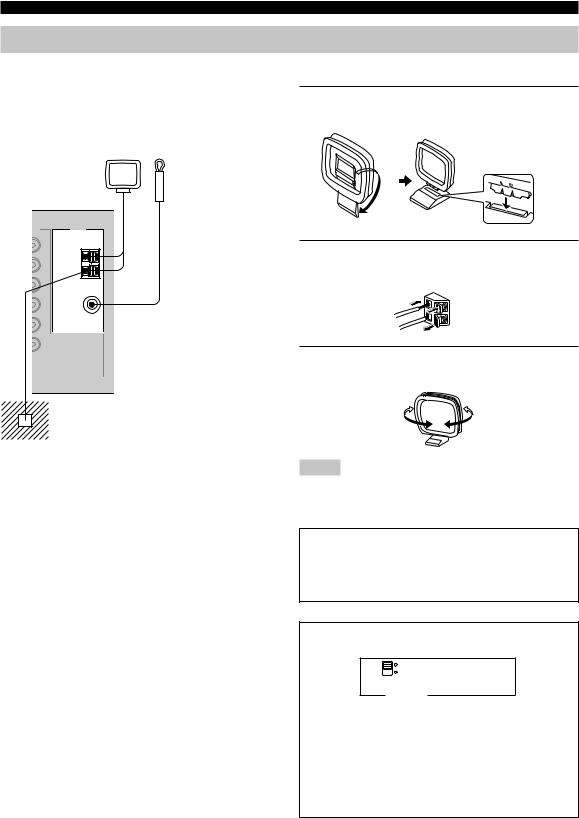
CONNECTIONS
Connecting the antennas
Both AM and FM indoor antennas are included with this unit. In general, these antennas should provide sufficient signal strength.
Connect each antenna correctly to the designated terminals.
AM loop antenna |
Indoor FM |
|
|
(included) |
antenna |
|
|
(included) |
DEO |
TUNER |
|
|
AM |
|
|
ANT |
|
|
GND |
|
|
75Ω UNBAL. |
|
|
FM |
|
|
ANT |
|
|
MONITOR |
|
|
OUT |
|
|
|
Ground (GND terminal) |
|
|
For maximum safety and minimum |
|
|
interference, connect the antenna GND |
|
|
terminal to a good earth ground. A good |
|
|
earth ground is a metal stake driven into |
|
|
moist earth. |
■ Connecting the AM loop antenna
1 Set up the AM loop antenna, then connect it to the terminals on this unit.
2 Press and hold the tab to insert the AM loop antenna lead wires into the AM ANT and GND terminals.
3 Orient the AM loop antenna for the best reception.
Notes
•The AM loop antenna should be placed away from this unit.
•The AM loop antenna should always be connected, even if an outdoor AM antenna is connected to this unit.
A properly installed outdoor antenna provides clearer reception than an indoor one. If you experience poor reception quality, an outdoor antenna may improve the quality. Consult the nearest authorized YAMAHA dealer or service center about the outdoor antennas.
FREQUENCY STEP switch (General model only)
50 kHz/ 9kHz
100 kHz/10kHz
FM/AM
FREQUENCY STEP
Because the inter-station frequency spacing differs in different areas, set the FREQUENCY STEP switch (located on the rear panel) according to the frequency spacing in your area.
North, Central and South America: 100 kHz/10 kHz Other areas: 50 kHz/9 kHz
Before setting this switch, disconnect the AC power plug of this unit from the AC outlet.
12
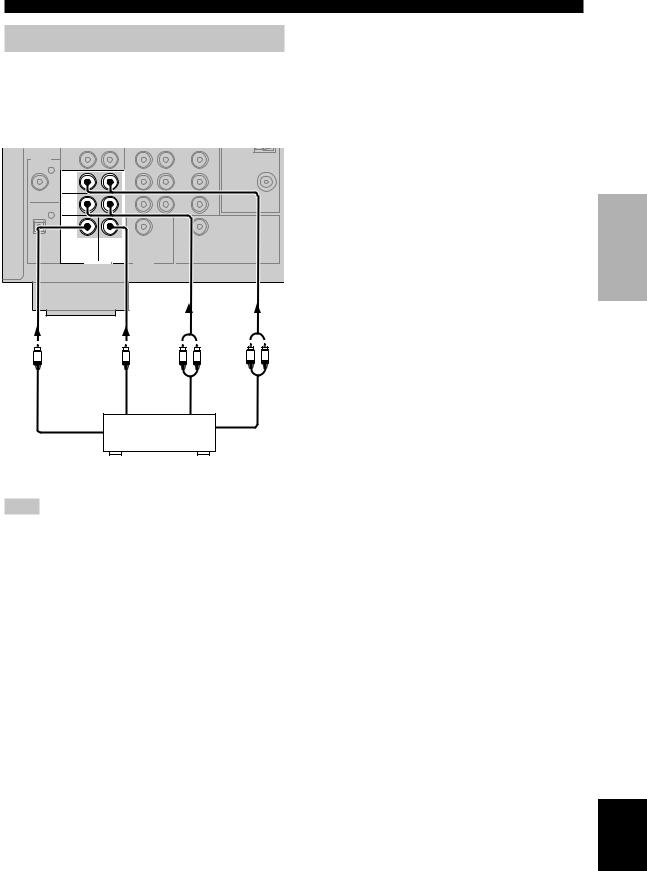
Connecting an external decoder
This unit is equipped with 6 additional input jacks (MAIN left and right, CENTER, SURROUND left and right and SUBWOOFER) for discrete multi-channel input from a component equipped with a multi-channel decoder and 6 channel output jacks such as a DVD/SACD player.
|
/CD-R |
|
|
|
DIGITAL |
OUT |
|
V-AUX |
|
(REC) |
|
|
||
INPUT |
|
|
|
75Ω UNBAL. |
CD |
2 |
|
|
|
|
|
|
||
|
MAIN |
|
IN |
FM |
|
|
ANT |
||
|
|
|
|
|
|
|
|
VCR |
|
COAXIAL |
|
|
|
|
OPTICAL |
SURROUND |
|
OUT |
|
DVD |
1 |
|
|
|
|
|
SUB |
|
MONITOR |
|
|
WOOFER |
|
OUT |
|
SUB |
|
|
|
|
WOOFER CENTER |
|
|
|
|
6CH INPUT |
OUTPUT |
|
|
L |
R |
L R |
CENTER |
SURROUND |
|
SUBWOOFER |
MAIN |
|
DVD/SACD player
Note
•When you select 6CH INPUT as the input source, the unit automatically turns off the digital sound field processor, and you cannot use DSP programs.
CONNECTIONS
PREPARATION
English
13
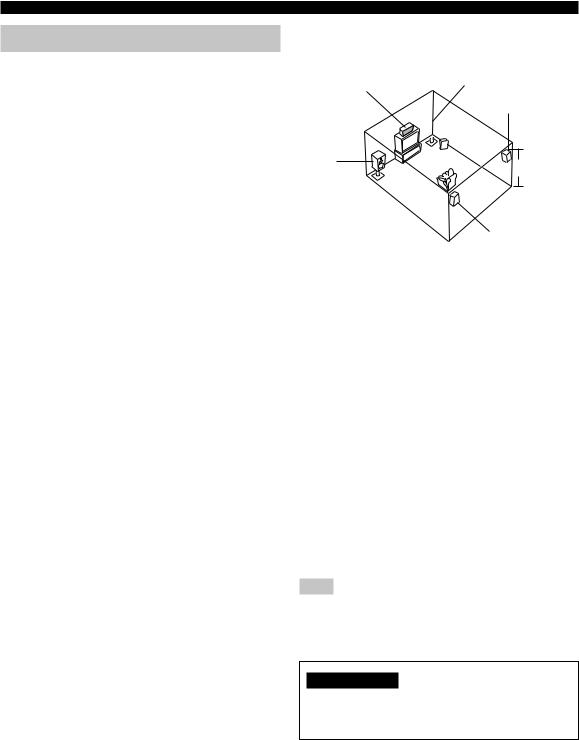
CONNECTIONS
Connecting the speakers
■ Speakers
This unit has been designed to provide the best soundfield quality with a 5-speaker system, using main left and right speakers, rear left and right speakers and a center speaker. If you use different brands of speakers (with different tonal qualities) in your system, the tone of a moving human voice and other types of sound may not shift smoothly. We recommend that you use speakers from the same manufacturer or speakers with the same tonal quality.
The main speakers are used for the main source sound plus effect sounds. They will probably be the speakers from your present stereo system. The rear speakers are used for effect and surround sounds. The center speaker is for the center sounds (dialog, vocals, etc.).
The main speakers should be high-performance models and have enough power-handling capacity to accept the maximum output of your audio system. The other speakers do not have to be equal to the main speakers. For precise sound localization, however, it is ideal to use the models of equivalent performance with the main speakers.
Use of a subwoofer expands your sound field
It is also possible to further expand your system with the addition of a subwoofer. The use of a subwoofer is effective not only for reinforcing bass frequencies from any or all channels, but also for reproducing the LFE (low-frequency effect) channel with high fidelity when playing back Dolby Digital or DTS signals. The YAMAHA Active Servo Processing Subwoofer System is ideal for natural and lively bass reproduction.
■ Speaker placement
Refer to the following diagram when you place the speakers.
Center speaker |
Main speaker (R) |
Rear speaker (R)
 Subwoofer
Subwoofer
Main
1.8 m (6 feet)
speaker (L)
Rear speaker (L)
Main speakers
Place the main left and right speakers an equal distance from the ideal listening position. The distance between each speaker and each side of the video monitor should also be the same.
Center speaker
Align the front face of the center speaker with the front face of your video monitor. Place the speaker as close to the monitor as possible (such as directly over or under the monitor) and centrally between the main speakers.
Rear speakers
Place these speakers behind your listening position, facing slightly inwards, about 1.8 m (6 feet) above the floor.
Subwoofer
The position of the subwoofer is not so critical, because low bass sounds are not highly directional. However, it is better to place the subwoofer near the main speakers. Turn it slightly toward the center of the room to reduce wall reflections.
Note
•If you do not use any of effect speakers (rear and/or center), change the settings of “SOUND 1 SPEAKER SET” items at the set menu to direct signals to other terminals you have connected speakers to.
CAUTION
Use magnetically shielded speakers. If these speakers still create interference with the monitor, place the speakers away from the monitor.
14
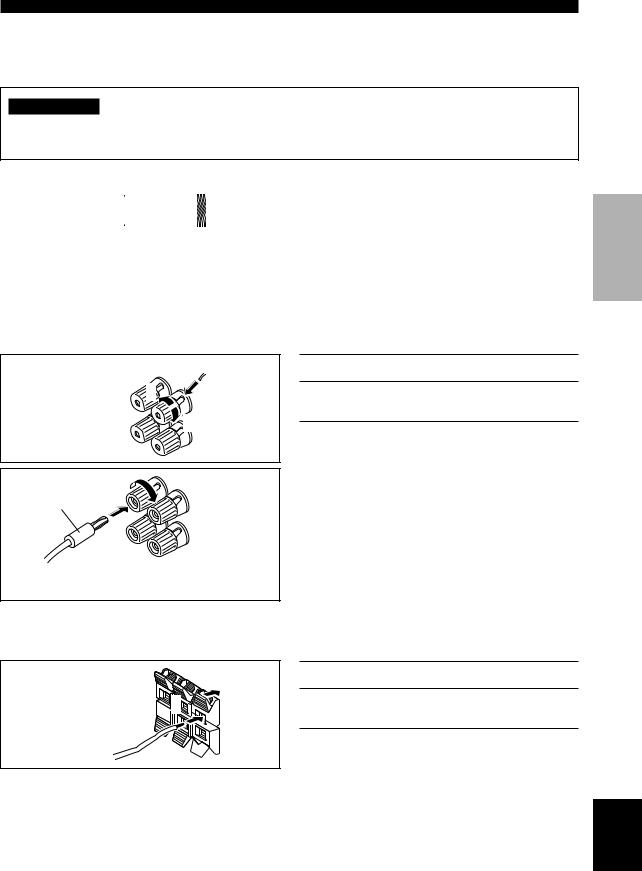
CONNECTIONS
■ Connections
Be sure to connect the left channel (L), right channel (R), “+” (red) and “–” (black) in accordance with the markers on this unit, the speakers, and the speaker cables. If the connections are faulty, no sound will be heard from the speakers, and if the polarity of the speaker connections is incorrect, the sound will be unnatural and lack bass.
CAUTION
•Use speakers with the specified impedance shown on the rear panel of this unit.
•Do not let the bare speaker wires touch each other or any metal part of this unit. This could damage this unit and/ or the speakers.
|
|
|
|
|
|
|
|
|
A speaker cord is actually a pair of insulated cables |
10 mm (3/8”) |
|
|
|
|
|
|
|
running side by side. One cable is colored or shaped |
|
|
|
|
|
|
|
|
differently, perhaps with a stripe, groove or ridge. |
||
|
|
|
|
|
|
|
|
|
|
|
|
|
|
|
|
|
|
|
|
|
|
|
|
|
|
|
|
|
|
1 |
|
|
2 |
|
|
|
1 Remove approximately 10 mm (3/8”) of |
||
|
|
|
|
|
insulation from each of the speaker cables. |
||||
|
|
|
|
|
|
|
|
|
|
|
|
|
|
|
|
|
|
|
|
|
|
|
|
|
|
|
|
|
2 Twist the exposed wires of the cable |
|
|
|
|
|
|
|
|
|
together to prevent short circuits. |
Connecting to the MAIN A SPEAKERS terminals
2 
Red: positive (+) |
1 |
Black: negative (–) |
3
Banana plug
1 Unscrew the knob.
2 Insert one bare wire into the hole in the side of each terminal.
3 Tighten the knob to secure the wire.
y
(With the exception of U.K., Europe, Korea, and Singapore models)
•You can also use banana plug connectors. First, tighten the knob and then insert the banana plug connector into the end of the corresponding terminal.
(With the exception of U.K., Europe, Korea, and Singapore models)
PREPARATION
Connecting to the MAIN B, CENTER and REAR SPEAKERS terminals
Red: positive (+) Black: negative (–)
1
 3
3
 2
2 

1 Press and open the tab.
2 Insert one bare wire into the hole of each terminal.
3 Release the tab to secure the wire.
English
15
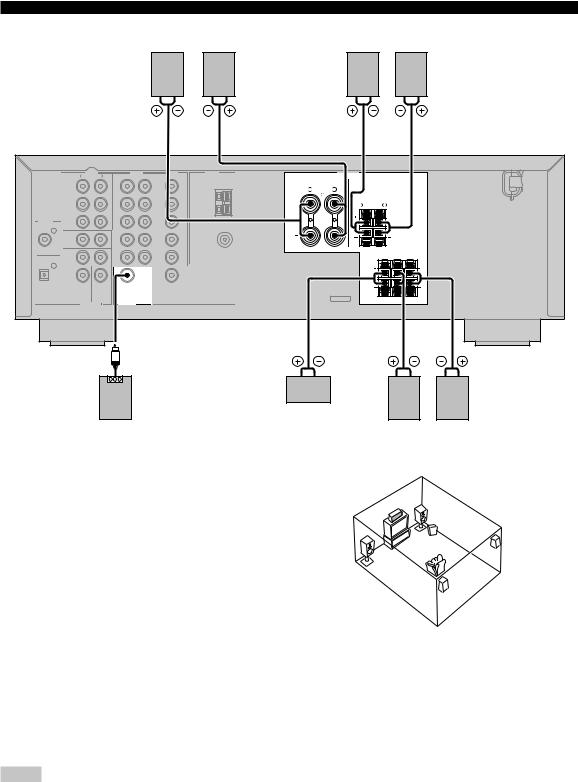
CONNECTIONS
Main A speaker |
Main B speaker |
||
Right |
Left |
Right |
Left |
12
|
AUDIO |
|
AUDIO |
VIDEO |
TUNER |
|
SPEAKERS |
|
|
|
|
|
|
R |
L |
R |
L |
|
|
|
CLASS 2 WIRING |
|
|
|
|
|
CD |
|
|
|
DVD |
|
A |
|
|
|
|
|
|
|
|
|
|
|
R |
MAIN |
L |
|
|
|
|
|
|
|
|
|
|
AM |
|
|
B |
|
|
|
|
|
|
|
|
|
ANT |
|
|
|
|
|
|
|
IN |
|
|
|
D-TV |
|
|
|
|
|
|
|
|
(PLAY) |
|
|
|
/CBL |
GND |
|
R |
MAIN |
L |
|
|
|
MD |
|
|
|
|
|
|
|
|
|
|
|
|
|
|
|
|
|
|
|
|
|
|
|
|
|
/CD-R |
|
|
|
|
|
|
|
|
|
|
|
DIGITAL |
OUT |
|
|
|
V-AUX |
|
|
|
|
|
|
|
(REC) |
|
|
|
|
|
|
|
|
|
|
||
INPUT |
|
|
|
|
|
75Ω UNBAL. |
|
|
|
|
|
|
CD |
2 |
|
|
|
|
|
|
|
|
|
|
|
|
|
|
|
|
|
|
|
|
|
|
||
|
MAIN |
|
|
|
IN |
FM |
|
|
|
|
|
|
|
|
|
|
ANT |
|
|
|
|
|
|
||
|
|
|
|
|
|
|
|
|
|
|
|
|
|
|
|
|
|
VCR |
|
|
MAIN A OR B : 6Ω MIN./SPEAKER |
|
|
|
REAR |
COAXIAL |
|
|
|
|
|
|
|
|
|
(SURROUND) |
||
OPTICAL |
SURROUND |
|
|
|
OUT |
|
|
|
|
CENTER |
R |
L |
|
|
|
|
|
|
|
|
|
|
|||
DVD |
1 |
|
|
|
|
|
|
|
|
|
|
|
|
|
|
|
SUB |
|
MONITOR |
|
|
|
|
|
|
|
|
|
|
WOOFER |
|
OUT |
|
|
|
|
|
|
|
SUB |
|
|
|
|
|
|
|
|
|
|
|
|
WOOFER |
CENTER |
|
|
|
|
|
|
|
|
|
|
|
|
|
|
|
|
|
|
|
|
CENTER : |
6Ω MIN./SPEAKER |
|
|
6CH INPUT |
OUTPUT |
|
|
|
|
|
REAR : |
6Ω MIN./SPEAKER |
|||
|
|
|
|
|
|
|
|
|
||||
|
3 |
|
|
|
4 |
Center |
5 |
|
6 |
|
|
|
|
|
Subwoofer |
speaker |
|
Right |
Left |
system |
|
|
Rear speaker |
|
MAIN SPEAKERS terminals
You can connect up to two speaker systems to these terminals. When using only one speaker system, connect it to either of the MAIN A or the MAIN B terminals.
REAR SPEAKERS terminals
A rear speaker system can be connected to these terminals.
CENTER SPEAKER terminals
A center speaker can be connected to these terminals.
31
4
2
5
6
The diagram shows the speaker layout in the listening room.
SUBWOOFER jack
When using a subwoofer with built-in amplifier, including the YAMAHA Active Servo Processing Subwoofer System, connect the input jack of the subwoofer system to this jack. This unit will direct low bass signals distributed from the main, center and/or rear channels to this jack in accordance with your SPEAKER SET selections. The LFE (lowfrequency effect) signals generated when Dolby Digital or DTS is decoded are also directed to this jack in accordance with your SPEAKER SET selections.
Notes
•The cut-off frequency of the SUBWOOFER jack is 90 Hz.
•If you do not use a subwoofer, allocate the signals to the main left and right speakers by changing the setting of “SOUND 1 SPEAKER SET” item “1D BASS” on the set menu to MAIN.
•Use the control on the subwoofer to adjust its volume level. You can also adjust the volume level by using this unit’s remote control (see “SETTING THE SPEAKER LEVELS” on page 45).
16
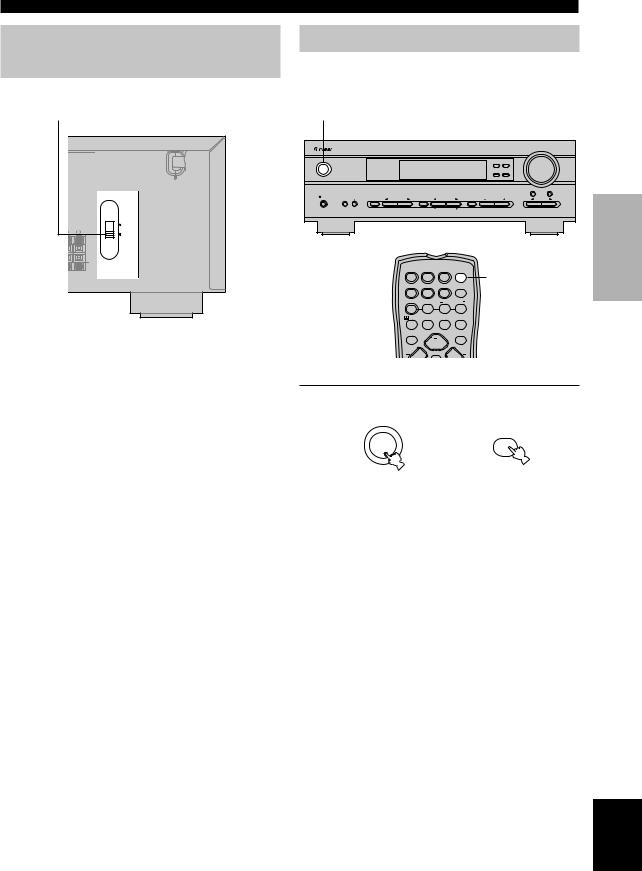
Connecting the power supply
cords
VOLTAGE SELECTOR
|
VOLTAGE |
|
SELECTOR |
REAR |
110V-120V |
URROUND) |
|
L |
220V-240V |
|
|
N./SPEAKER |
|
N./SPEAKER |
|
■Connecting the AC power cord
Plug in this unit to a wall outlet.
■VOLTAGE SELECTOR
(General model only)
The VOLTAGE SELECTOR on the rear panel of this unit must be set for your local main voltage BEFORE plugging into the AC main supply. Voltages are 110V- 120V/220V-240V AC, 50/60 Hz.
CONNECTIONS
Turning on the power
When all connections are complete, turn on the power of this unit.
1
|
|
|
|
|
|
|
VOLUME |
STANDBY |
|
|
|
|
|
|
|
/ON |
|
|
|
|
|
|
|
SILENT |
SPEAKERS |
|
|
|
|
|
|
|
STEREO |
PROGRAM |
A/B/C/D/E |
PRESET/TUNING |
CONTROL |
BASS/TREBLE |
INPUT |
|
EFFECT |
|
NEXT |
SET MENU |
|
|
|
DVD D-TV/CBL |
VCR |
POWER |
1 |
CD MD/CD-R V-AUX |
6CH IN |
||
TUNER A/B/C/D/E |
PRESET |
|
|
/DTS 6.1/5.1 |
NIGHT |
SLEEP |
|
TEST |
|
STEREO |
|
VOLUME |
|
|
|
PROG |
|
PROG |
|
1 Press STANDBY/ON (POWER on the remote control) to turn on the power of this unit.
|
POWER |
STANDBY |
or |
/ON |
|
Front panel |
Remote control |
The level of the main volume, and then the current DSP program name appear on the front panel display.
PREPARATION
English
17
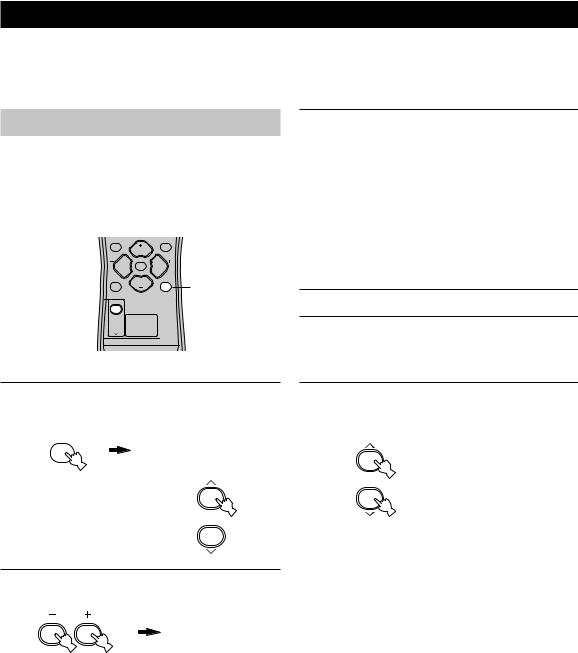
BASIC SYSTEM SETTINGS
The “BASIC” menu allows you to set some of the basic “SOUND” menu parameters with a minimum of effort. If you wish to configure the unit more precisely to suit your listening environment, use the more detailed parameters from the “SOUND” menu instead of those under the “BASIC” menu (See page 40). Altering any parameters in the BASIC menu will reset all parameters in the “SOUND” menu.
Using the basic menu
Use the remote control to make adjustments.
•Press SPEAKERS A/B on the front panel to select the main speakers you want to use, and set SPEAKERS ON/OFF to the ON position.
•Make sure you disconnect headphones from this unit.
TEST |
|
STEREO |
|
|
VOLUME |
|
|
PROG |
|
PROG |
|
|
MUTE |
|
|
LEVEL |
VOLUME |
SET MENU |
1 |
|
|
3,6 



 2,4
2,4
1 Press SET MENU.
“BASIC MENU” appears on the front panel display, as shown here.
SET MENU
BASIC MENU
If the front panel display changes to show anything other than “BASIC MENU”, press uuntil it displays “BASIC MENU”.
2 Press –/+ to enter into the BASIC menu.
The front panel display changes as shown here:
1 SETUP
3 Press u / dto change the display to the setting you want to alter.
SETUP
Changes the speaker and amplifier settings to suit the size of the room you are using. Refer to “Setting the unit to match your speaker system” on page 20 for more information.
SP LEVEL
Adjusts the output levels of the speakers.
Refer to “Setting speaker output levels” on page 20 for more information.
4 Press –/+ to enter the desired setting mode.
5 Change the unit settings to suit your listening environment. When you have finished, the unit will automatically return to the basic menu.
6 Press u / dto exit from the set menu.
The front panel display changes in the following order:
Exit
↑
BASIC
↓↑
SOUND
↓↑
INPUT
↓↑
OPTION
↓
Exit
18
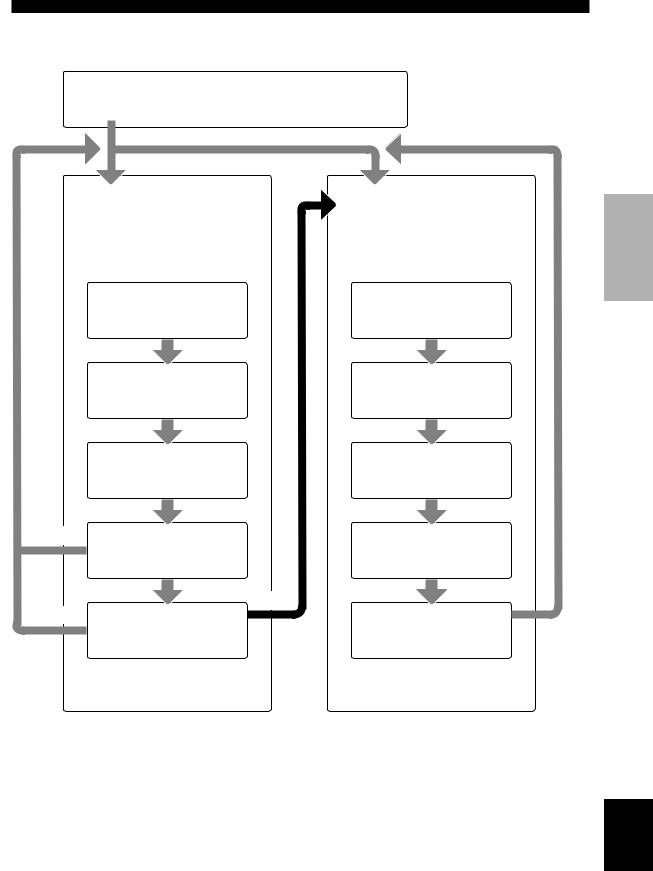
SET MENU
BASIC SOUND INPUT
1 SETUP
Press –/+ to alter the settings for each parameter. Use dto move to the next setting.
1 ROOM
Choose from S/M/L.
2 SUBWOOFER
Choose either of YES/NONE.
3 SPEAKERS
Choose from 2/3/4/5 spk.
CANCEL 4 SET/CANCEL
Choose either of SET/CANCEL.
BASIC SYSTEM SETTINGS
OPTION
2 SP LEVEL
Press –/+ to adjust the balance between each speaker and the left main speaker. Use dto move to the next setting.
1 L-R
PREPARATION
Adjust the balance between the main left and right speakers.
2 C
Adjust the balance between the main left and center speakers.
3 RL
Adjust the balance between the main left and rear left speakers.
4 RR
Adjust the balance between the rear left and rear right speakers.
SET |
NO |
|
|
YES 5 CHECK OK: |
5 SWFR |
Choose either of YES/NO. |
Adjust the balance between the main |
|
left speaker and the subwoofer. |
•After altering the “1 SETUP” parameters, readjust the output levels of the speakers at “2 SP LEVEL”.
•See pages 39 – 44 for a detailed explanation of the “SOUND”, “INPUT” and “OPTION” menus.
English
19
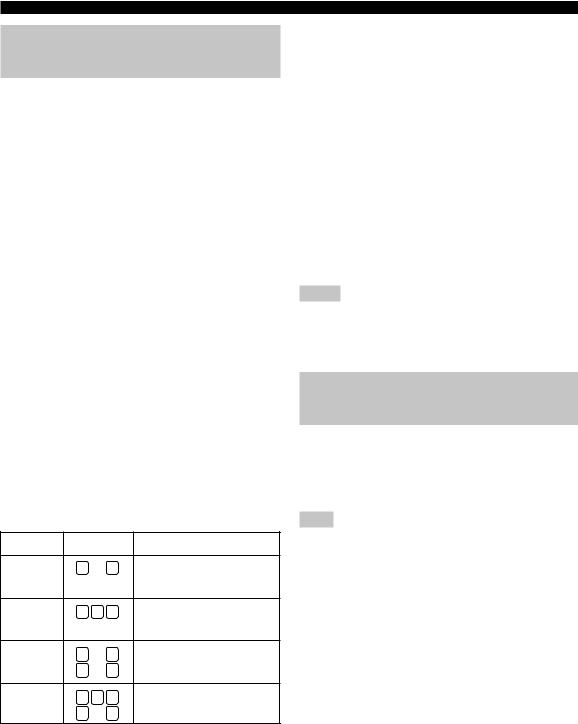
BASIC SYSTEM SETTINGS
Setting the unit to match your
speaker system
Follow the instructions below to set the amplifier output to match the size of your room and speakers. Press u/ d to cycle through parameters 1 through 4, and –/+ to alter the parameter setting.
Factory default settings are highlighted.
1ROOM
Settings: S, M, L
Select the size of the room you have installed your speakers in. Roughly speaking, the room sizes are defined as follows:
[U.S.A. and Canada models]
S: 16ft. x 3ft., 200sq.ft. (4.8 x 4m, 20m2) M: 20ft. x 16ft., 300sq.ft. (6.3 x 5.0m, 30m2) L: 26ft. x 19ft., 450sq.ft. (7.9 x 5.8m, 45m2)
[Other models]
S: 3.6m x 2.8m, 10m2 M: 4.8m x 4.0m, 20m2 L: 6.3m x 5.0m, 30m2
2SUBWOOFER
Settings: YES, NONE
Select YES if you have a subwoofer in your system, or NONE if you do not.
3SPEAKERS
Settings: 2, 3, 4, 5 (spk)
Select the number of speakers you wish to use in your speaker configuration. This number does not include your subwoofer.
Setting |
Display |
Speaker |
|
2spk |
L |
R |
Main L/Main R |
3spk |
L C R |
Main L/Center/Main R |
|
4spk |
L |
R |
Main L/Main R/Rear L/ |
|
RL |
RR |
Rear R |
5spk |
L C R |
Main L/Center/Main R/ |
|
|
RL |
RR |
Rear L/Rear R |
|
|
||
4SET or CANCEL
Select SET to confirm the changes you made to the above three settings. The unit will output a test tone to the speakers (see 5). Alternatively, select CANCEL to exit this menu without altering any of the unit settings.
5Use the test tone to check the speaker levels.
When you select SET in 4, the display changes to “CHECK: TestTone”, and the unit outputs a test tone to each of the speakers in turn. When the test tone begins, the display changes to “CHECK OK?-- YES”.
If the volume of the test tone varies between speakers, press –/+ to change the display to “NO”. The unit will automatically enter the “2 SP LEVEL” mode.
If the test tone is output at the same volume from all of the speakers, select “CHECK OK: YES”. Press d to exit from the SETUP menu.
Notes
•The unit cycles the test tone around each of the speakers in turn twice.
•The indicator of the speaker currently outputting the test tone flashes on the front panel display.
Setting speaker output levels
(SP LEVEL)
Use this menu to compare and adjust the test tone output from each speaker to the output from the left main (or left rear) speaker so that the volume level for all speakers is identical. Press u/ dto select a speaker, then adjust the balance using –/+.
Note
•The unit outputs the test tone from the selected speaker and the left main (or left rear) speaker in turn. The indicator of the speaker currently outputting the test tone flashes on the front panel display.
1L-R
Adjusts the balance between the main left and right speakers.
2C
Adjusts the balance between the main left and center speakers.
3RL
Adjusts the balance between the main left and rear left speakers.
4RR
Adjusts the balance between the rear left and rear right speakers.
5SWFR
Adjust the balance between the main left speaker and the subwoofer.
20

|
|
|
|
|
|
|
PLAYBACK |
|
1 |
|
|
|
|
|
|
7 |
5 Press INPUT l / h repeatedly (one of the |
|
|
|
|
|
|
input selector buttons on the remote control) |
||
|
|
|
|
|
|
|
|
to select the input source. |
|
|
|
|
|
|
|
VOLUME |
The selected input source name and input mode |
|
|
|
|
|
|
|
|
appear on the front panel display for a few seconds. |
STANDBY |
|
|
|
|
|
|
|
|
/ON |
|
|
|
|
|
|
|
|
|
|
|
|
|
|
|
|
DVD D-TV/CBL VCR |
SILENT |
SPEAKERS |
|
|
|
|
|
|
|
|
STEREO |
PROGRAM |
A/B/C/D/E |
PRESET/TUNING |
CONTROL |
BASS/TREBLE |
INPUT |
|
|
EFFECT |
|
NEXT |
SET MENU |
|
|
|
INPUT |
|
|
|
|
|
|
|
|
CD MD/CD-R V-AUX |
|
|
|
|
|
|
|
|
or |
|
|
|
|
|
|
|
|
TUNER |
3 4 |
8 |
7 |
5 5 |
Front panel |
Remote control |
|
DVD D-TV/CBL |
VCR |
POWER |
1 |
5 |
|
|
|
|
CD MD/CD-R V-AUX |
6CH IN |
5 |
||
|
TUNER A/B/C/D/E |
PRESET |
||
|
|
|||
|
/DTS 6.1/5.1 |
NIGHT |
SLEEP |
|
|
TEST |
|
STEREO |
7 |
|
VOLUME |
|
||
|
PROG |
|
PROG |
|
|
MUTE |
|
|
|
|
LEVEL |
|
SET MENU |
|
|
VOLUME |
|
|
|
8
1 Press STANDBY/ON (POWER on the remote control) to turn on the power.
|
POWER |
|
STANDBY |
or |
|
/ON |
||
|
||
Front panel |
Remote control |
2 Turn on the video monitor connected to this unit.
3 Press and set SPEAKERS |
SPEAKERS |
|
ON/OFF inward (ON). |
ON |
A |
|
OFF |
B |
4 Press and set SPEAKERS |
SPEAKERS |
|
A/B inward (A) or outward |
ON |
A |
(B) to select the main |
|
|
speakers you want to use. |
OFF |
B |
VCR |
V-AUX D-TV/CBL DVD MD/CD-R TUNER |
CD |
||
|
|
|
|
VOLUME |
DVD |
AUTO |
L R |
Selected input source
To select the audio source connected to the 6CH INPUT jacks
•Select the input to which the video source component is connected before selecting an audio source.
Press 6CH INPUT until “6CH INPUT” appears on the front panel display.
6CH INPUT |
6CH IN |
|
or |
Front panel |
Remote control |
Note
•If “6CH INPUT” is shown on the front panel display, no other source can be played. To select another input source, first press 6CH INPUT so that “6CH INPUT” disappears from the front panel display.
OPERATION |
BASIC |
|
|
English
21
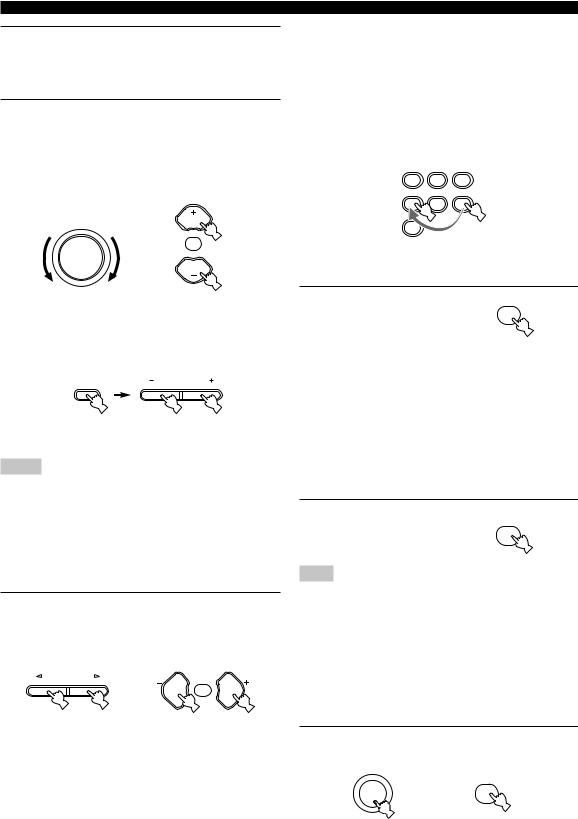
PLAYBACK
6 Start playback or select a broadcast station on the source component.
Refer to the operation instructions for the component.
7 Adjust the volume to the desired level.
The volume level is displayed digitally. Example: –70 dB
Control range: VOLUME MUTE (minimum) to 0 dB (maximum)
The volume level indicator also shows the current volume level as a bar graph.
VOLUME |
VOLUME |
|
|
|
MUTE |
|
or |
|
VOLUME |
Front panel |
Remote control |
If desired, use CONTROL and BASS/TREBLE –/+. These controls only effect the sound from the main speakers.
CONTROL |
BASS/TREBLE |
Front panel
Notes
•If you increase or decrease the high-frequency or the lowfrequency sound to an extreme level, the tonal quality from the center and rear speakers may not match that of the main left and right speakers.
•If you have connected a recording component to the VCR OUT, or MD/CD-R OUT jacks, and you notice distortion or low volume during playback from other components, try turning the recording component on.
8 Select a DSP program if desired.
Use PROGRAM l/ h(PROG –/+ on the remote control) to select a DSP program. See pages 27 – 30 for details about DSP programs.
PROGRAM |
PROG |
PROG |
|
or |
MUTE |
Front panel |
|
Remote control |
■ BGV (background video) function
The BGV function allows you to view images from a video source together with sounds from an audio source. For example, you can enjoy listening to classical music while watching beautiful scenery from a video source on the video monitor.
Select a source from the video group, then select a source from the audio group using the input selector buttons on the remote control.
DVD D-TV/CBL VCR
CD MD/CD-R V-AUX
■ To mute the sound
Press MUTE on the |
|
remote control. |
MUTE |
To resume audio output, press MUTE again.
y
•You can change the amount by which the unit reduces the volume in “OPTION 3 AUDIO MUTE” in the set menu.
•You can also cancel mute by pressing VOLUME +/–, etc.
•During muting, the MUTE indicator flashes on the front panel display.
■ Night listening mode
This mode reproduces dialogue clearly while reducing the volume of loud sound effects for easier listening at low volumes or at night.
Press NIGHT on the
remote control. |
NIGHT |
|
|
Press NIGHT once more to |
|
return to normal reproduction. |
|
Note
• Setting the unit in standby mode cancels night listening mode.
y
•You can use night listening mode with any of the sound field programs.
•The NIGHT indicator on the front panel display lights when the unit is in night listening mode.
•Night listening mode may vary in effectiveness depending on the input source and surround sound settings you use.
■ When you have finished using this unit
Press STANDBY/ON (POWER on the remote control) to set this unit in standby mode.
|
POWER |
STANDBY |
or |
/ON |
|
Front panel |
Remote control |
22
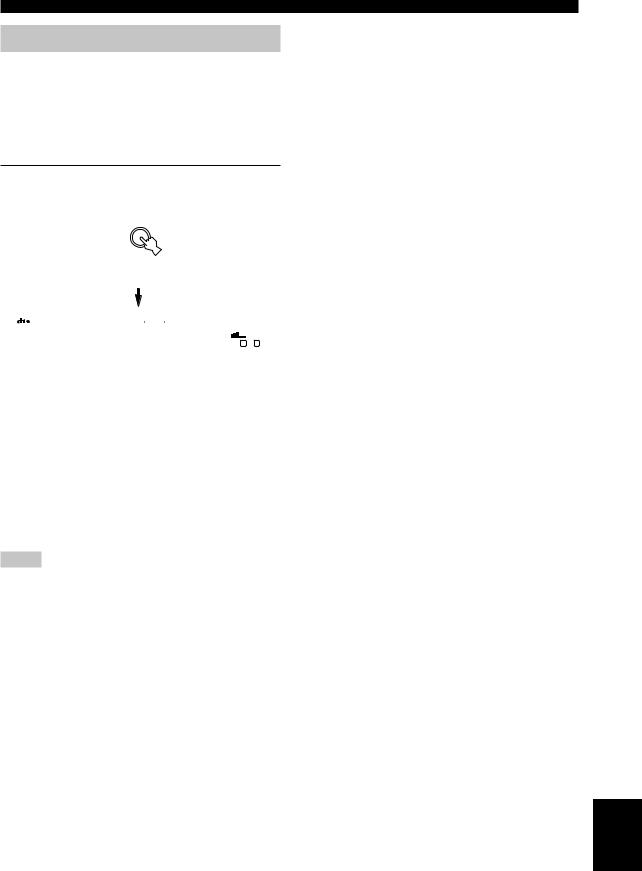
Input modes and indications
This unit is equipped with 2 types of input jacks for the CD and DVD sources only. You can select the type of input signals you wish to use.
Each time you turn on the unit power, the input mode is set to the “INPUT 2 INPUT MODE” setting defined in the set menu.
Press INPUT MODE repeatedly until the desired input mode is shown on the front panel display.
INPUT MODE
Front panel
|
|
VCR V-AUX D-TV/CBL |
|
DVD MD/CD-R TUNER CD |
|
|
|
||||
|
|
|
|
|
|
|
|
|
VOLUME |
|
|
|
|
DVD |
|
AUTO |
|
|
|
|
|
||
|
|
|
|
|
|
|
|
||||
|
|
|
|
|
|
L R |
|
||||
|
|
|
|
|
|
|
|
||||
|
|
|
|
|
|
|
|||||
|
|
|
|
|
|
|
|
|
|
|
|
|
|
|
|
|
|
|
|
||||
|
|
|
Input mode |
|
|
|
|||||
AUTO: |
In this mode, the input signal is selected |
||||||||||
|
|
automatically as follows: |
|
|
|
||||||
|
|
1) Digital signal |
|
|
|
|
|
|
|
|
|
|
|
2) Analog signal |
|
|
|
|
|
|
|
|
|
DTS: |
In this mode, only digital input signals |
||||||||||
|
|
encoded with DTS are selected, even if the |
|||||||||
|
|
unit is receiving another signal |
|
|
|
||||||
|
|
simultaneously. |
|
|
|
|
|
|
|
|
|
ANALOG: In this mode, only analog input signals are selected, even the unit is receiving digital signals at the same time.
Notes
•When AUTO is selected, this unit automatically determines the type of signal. If it detects a Dolby Digital or DTS signal, the decoder automatically switches to the appropriate setting.
•When playing a disc encoded with Dolby Digital or DTS on some LD or DVD players, there is a delay in sound output for a moment when playback resumes after a search, because the unit must select the digital signal again.
•When playing a LD source that has not been digitally recorded, the unit may not output any sound for some LD players. In this case, set the input mode to ANALOG.
PLAYBACK
■ Notes on digital signals
The digital input jacks of this unit can handle 96 kHz sampling digital signals. Note the following when a digital signal with a sampling frequency greater than 48 kHz is input to this unit:
•You cannot use any DSP programs.
•The unit will output sound as 2-channel stereo from the main left and right speakers only. Therefore, you cannot adjust the level of the effect speakers while listening to such a source.
■ Notes on playing DTS-CD/LDs
•If the digital output data of the player has been processed in any way, the unit may not be able to perform DTS decoding even if there is a digital connection between this unit and the player.
•If you play a source encoded with a DTS signal and set the input mode to ANALOG, the unit may reproduce the noise of an unprocessed DTS signal. In this case, connect the source to a digital input jack on this unit and set the input mode to AUTO or DTS.
•If you switch the input mode to ANALOG while playing a source encoded with a DTS signal, the unit does not output any sound.
•If you play a source encoded with a DTS signal with the input mode set to AUTO;
–The unit automatically switches to the DTSdecoding mode (The “t” indicator lights up) after detecting the DTS signal. When playback of the DTS source is completed, the “t” indicator may flash. While this indicator is flashing, the unit can only reproduce DTS source. If you want to play a normal PCM source immediately, change the input mode back to AUTO.
–When the input mode is set to AUTO and a search or skip operation is performed during playback of a DTS source, the “t” indicator may flash. If this state continues for longer than 30 seconds, the unit will automatically switch from “DTS-decoding” mode to PCM digital signal input mode. The “t” indicator will turn off.
OPERATION |
BASIC |
|
|
English
23
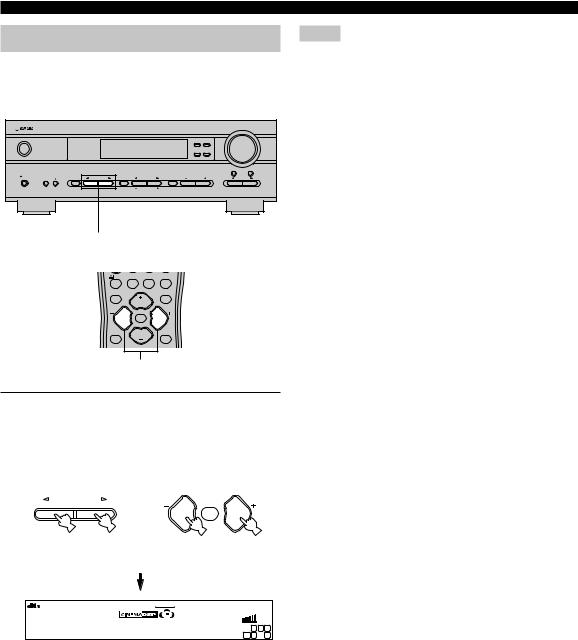
PLAYBACK
Selecting a sound field program
You can enhance your listening experience by selecting a DSP program. For details about each program, see pages 27 – 30.
|
|
|
|
|
|
|
VOLUME |
STANDBY |
|
|
|
|
|
|
|
/ON |
|
|
|
|
|
|
|
SILENT |
SPEAKERS |
|
|
|
|
|
|
|
STEREO |
PROGRAM |
A/B/C/D/E |
PRESET/TUNING |
CONTROL |
BASS/TREBLE |
INPUT |
|
EFFECT |
|
NEXT |
SET MENU |
|
|
|
PROGRAM l / h
/DTS 6.1/5.1 NIGHT |
SLEEP |
TEST |
STEREO |
VOLUME |
|
PROG |
PROG |
MUTE |
|
LEVEL |
SET MENU |
VOLUME |
|
PROG –/+
Press PROGRAM l / h (PROG –/+ on the remote control) repeatedly to select the desired program (including sub-programs if available).
The name of the selected program (or sub-program) appears on the front panel display.
PROGRAM |
PROG |
PROG |
or |
|
MUTE |
Front panel |
|
Remote control |
VCR V-AUX D-TV/CBL |
DVD |
MD/CD-R TUNER CD |
VOLUME
Adventure |
L C R |
|
LFE RL RR |
Program No. 7, 8 and 9 have two sub-programs respectively. Refer to page 29 for details.
Notes
•There are 9 programs with sub-programs available with this unit. However, the selection depends on the input signal format and not all sub-programs can be used with all input signal formats.
•You cannot use the digital sound field processor with a source connected to the 6CH INPUT jacks of this unit or when the unit is reproducing a digital source with a sampling frequency greater than 48 kHz.
•The acoustics of your listening room affect the DSP program. Minimize the sound reflections in your room to maximize the effect created by the program.
•When you select an input source, this unit automatically selects the last DSP program used with that source.
•When you set this unit in standby mode, it stores the current source and DSP program in memory and automatically selects them when you turn on the power again.
•If the unit receives a Dolby Digital or DTS signal when the input mode is set to AUTO, the DSP program (No. 7–9) automatically switches to the appropriate decoding program.
•When the unit is reproducing a monaural source with PRO LOGIC or PRO LOGIC/Enhanced, or PRO LOGIC II Movie, no sound is output from the main and rear speakers. Sound can only be heard from the center speaker. (If “1A CENTER” on the set menu is set to NON, the center channel sound is output from the main speakers.)
y
•Select a program based on your listening preference. Program names are just for reference.
24
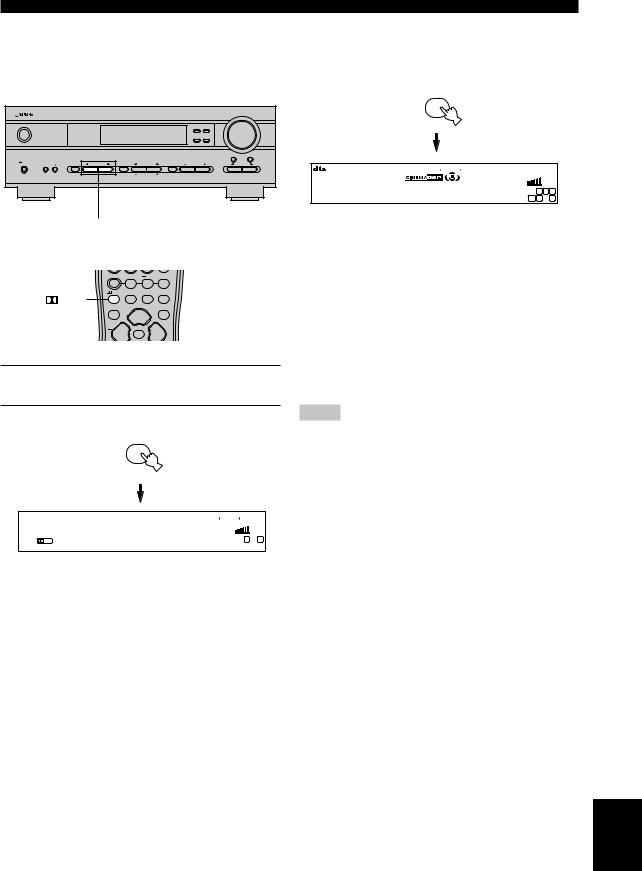
■ Selecting PRO LOGIC or PRO LOGIC II
You can listen to 2-channel sources decoded into five discrete channels by selecting PRO LOGIC or PRO LOGIC II in program No. 9.
|
|
|
|
|
|
|
VOLUME |
STANDBY |
|
|
|
|
|
|
|
/ON |
|
|
|
|
|
|
|
SILENT |
SPEAKERS |
|
|
|
|
|
|
|
STEREO |
PROGRAM |
A/B/C/D/E |
PRESET/TUNING |
CONTROL |
BASS/TREBLE |
INPUT |
|
EFFECT |
|
NEXT |
SET MENU |
|
|
|
PROGRAM l / h
TUNER A/B/C/D/E |
PRESET |
/DTS 6.1/5.1 |
NIGHT SLEEP |
/DTS |
|
TEST |
STEREO |
VOLUME |
|
PROG |
PROG |
MUTE
1 Select a 2-channel source and start playback on the source component.
2 Press q/DTS.
 /DTS
/DTS
VCR |
V-AUX D-TV/CBL DVD MD/CD-R TUNER |
CD |
|
|
|
VOLUME |
|
PL |
PRO LOGIC |
L R |
|
|
The display cycles as follows each time you press q/ DTS:
PRO LOGIC→PRO LOGIC Enhanced→PRO LOGIC II Movie→PRO LOGIC II Music→PRO LOGIC→....
y
•You can select PRO LOGIC, PRO LOGIC Enhanced, PRO LOGIC II Movie, and PRO LOGIC II Music by pressing PROGRAM l/ hon the front panel repeatedly.
PLAYBACK
■ Playing Dolby Digital EX or DTS ES material
Press 6.1/5.1 to turn on the Dolby Digital + Matrix 6.1 or DTS + Matrix 6.1 decoder.
6.1/5.1
(Example)
VCR |
V-AUX D-TV/CBL DVD MD/CD-R TUNER |
CD |
||
MATRIX |
|
|
|
VOLUME |
|
|
|
|
|
Matrix 6.1 |
L C R |
|
LFE RL RR |
The display changes AUTO → Matrix6.1 → OFF each time 6.1/5.1 is pressed.
AUTO: |
This mode automatically switches Dolby |
|
Digital + Matrix 6.1 and DTS + Matrix 6.1 |
|
depending on the signal. Virtual rear center |
|
speaker does not work for 5.1 channel |
sources.
Matrix 6.1: This setting produces 6-channel playback of
|
the input source using the Matrix 6.1 |
|
decoder. The virtual rear center speaker can |
|
be used when playing a 5.1-channel source. |
OFF: |
Virtual rear center speaker does not work in |
|
this setting. |
Notes
•Some 6.1-channel compatible discs do not have a signal (flag) that this unit can automatically detect. Select “Matrix 6.1” to play these kinds of discs with 6.1-channel sound.
•6.1-channel playback is not possible even if you press 6.1/5.1 in the following cases:
1 When effects are turned off.
2 When the source connected to the 6CH INPUT jacks is being played.
3 When the unit is reproducing a Dolby Digital KARAOKE source.
4 When headphones are connected to the PHONES jack.
•The input mode resets to AUTO when you turn the unit power off.
OPERATION |
BASIC |
|
|
English
25
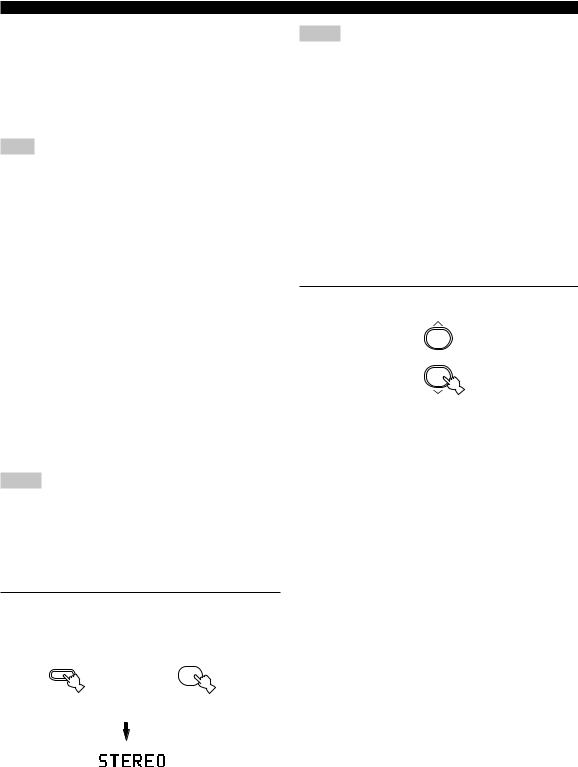
PLAYBACK
■ Virtual CINEMA DSP
With Virtual CINEMA DSP, you can enjoy all DSP programs without rear speakers. It creates virtual speakers to reproduce a natural sound field.
You can listen to virtual CINEMA DSP by setting “1C REAR LR” in the set menu to NON. Sound field processing changes to VIRTUAL CINEMA DSP automatically.
Note
•This unit is not set in the virtual CINEMA DSP mode even if “1C REAR LR” is set to NON in the following cases:
–when the 5ch Stereo, DOLBY DIGITAL, Pro Logic, Pro Logic II, or DTS program is selected;
–when the sound effect is turned off;
–when 6CH INPUT is selected as the input source;
–when a digital signal with a sampling frequency greater than 48 kHz is input to this unit;
–when using the test tone; or
–when connecting the headphones.
■ SILENT CINEMA DSP
You can enjoy a powerful sound field similar to what you could expect from actual speakers through headphones, with SILENT CINEMA DSP. You can listen to SILENT CINEMA DSP by connecting your headphones to the PHONES jack while the digital sound field processor is on. The “SILENT” indicator lights up on the front panel display. (When sound effects are off, the unit reproduces the source in normal stereo.)
To listen to sounds with headphones only, press SPEAKERS ON/OFF to turn off the output of all the speakers.
Notes
•This feature is not available when 6CH INPUT is selected or the unit is receiving a digital signal with a sampling frequency greater than 48 kHz.
•The sound from the LFE channel will be mixed and output from the headphones.
■ Normal stereo reproduction
Press STEREO to turn off the sound effect for normal stereo reproduction.
Press STEREO again to turn the sound effect back on.
STEREO |
STEREO |
|
or |
EFFECT |
|
Front panel |
Remote control |
Notes
•If you turn off the sound effects, no sound is output from the center speaker or rear speakers.
•If you turn off the sound effects while the unit is reproducing sound from a Dolby Digital or DTS signal, the dynamic range of the signal is automatically compressed and the unit will mix the sounds of the center and rear speaker channels and output them from the main speakers.
•The volume may be greatly reduced when you turn off the sound effects or if you set “SOUND 4 D. RANGE (dynamic range)” on the set menu to MIN. In this case turn on the sound effect.
y
•During stereo reproduction, you can display information such as the type, format and sampling frequency of the signal input from the components connected to this unit.
(While playing a source)
1 Press d to display the information about the input signal.
(Format): The display shows the signal format. When the unit cannot detect a digital signal it automatically switches to analog input.
in: The display shows the number of input signal source channels, as follows: For multi-channel soundtrack such as front 3 channels, rear 2 channels and LFE, the display shows “3/2/ LFE”.
fs: The display shows the sampling frequency. When the unit is unable to detect the sampling frequency “Unknown” shows in the front panel display.
rate: The display shows the bit rate. When the unit is unable to detect the bit rate “Unknown” shows in the front panel display.
flg: The display shows the flag - data encoded in a DTS or Dolby Digital signal that causes this unit to automatically switch to the appropriate decoder for playback.
26
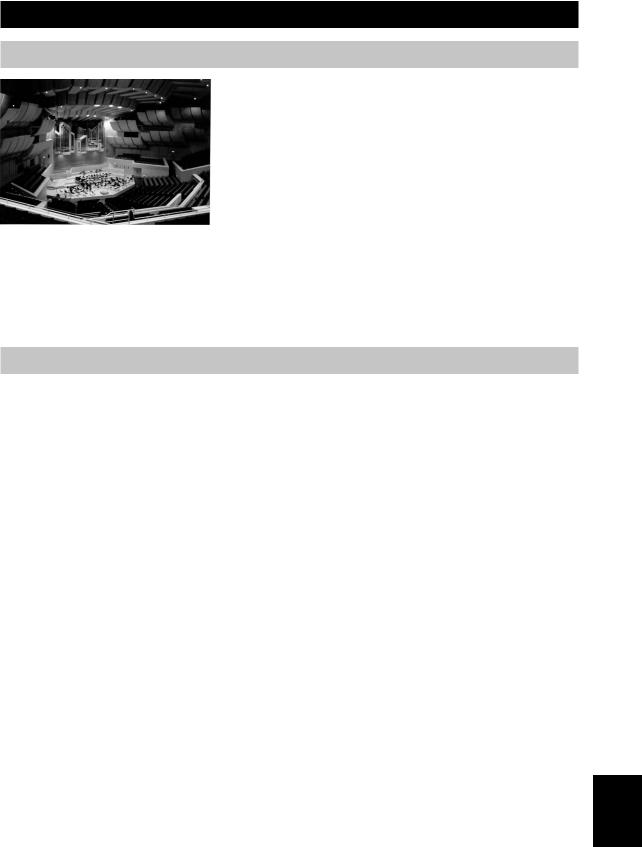
DIGITAL SOUND FIELD PROCESSING (DSP)
Understanding sound fields
A sound field is defined as the “characteristic sound reflections of a particular space.” In concert halls and other music venues, we hear early reflections and reverberations as well as the direct sound produced by the artist(s). The variations in the early reflections and other reverberations among the different music venues is what gives each venue its special and recognizable sound quality.
YAMAHA sent teams of sound engineers all around the world to measure the sound reflections of famous concert halls and music venues, and collect detailed sound field information such as the direction, strength, range, and delay time of those reflections. Then we stored this enormous amount of data in the ROM chips of this unit.
■ Recreating a sound field
Recreating the sound field of a concert hall or an opera house requires localizing the virtual sound sources in your listening room. The traditional stereo system that uses only two speakers is not capable of recreating a realistic sound field. YAMAHA’s DSP requires four effect speakers to recreate sound fields based on the measured sound field data. The processor controls the strength and delay time of the signals output from the four effect speakers to localize the virtual sound sources and fully encompass the listener.
Hi-Fi DSP programs
The following list gives you a brief description of the sound fields produced by each of the DSP programs. Keep in mind that most of these are precise digital recreations of actual acoustic environments.
No. |
Program |
Features |
|
|
|
1 |
CONCERT HALL |
A large round concert hall with a rich surround effect. Pronounced reflections from all directions |
|
|
emphasize the extension of sounds. The sound field has a great deal of presence, and your virtual |
|
|
seat is near the center, close to the stage. |
|
|
|
2 |
JAZZ CLUB |
This is the sound field at stage front in “The Bottom Line”, a famous New York jazz club, that |
|
|
seats up to 300 people. Its wide left to right seating arrangement offers a real and vibrant sound. |
|
|
|
3 |
ROCK CONCERT |
The ideal program for lively, dynamic rock music. The data for this program was recorded at LA’s |
|
|
“hottest” rock club. The listener’s virtual seat is at the center-left of the hall. |
|
|
|
4 |
ENTERTAINMENT/ |
This program recreates the acoustic environment of a lively disco in the heart of a big city. The |
|
Disco |
sound is dense and highly concentrated. It is also characterized by a high-energy, “immediate” |
|
|
sound. |
|
|
|
|
ENTERTAINMENT/ |
Using this program increases the listening position range. This is a sound field suitable for |
|
5ch Stereo |
background music at parties, etc. |
|
|
|
OPERATION |
BASIC |
|
|
English
27
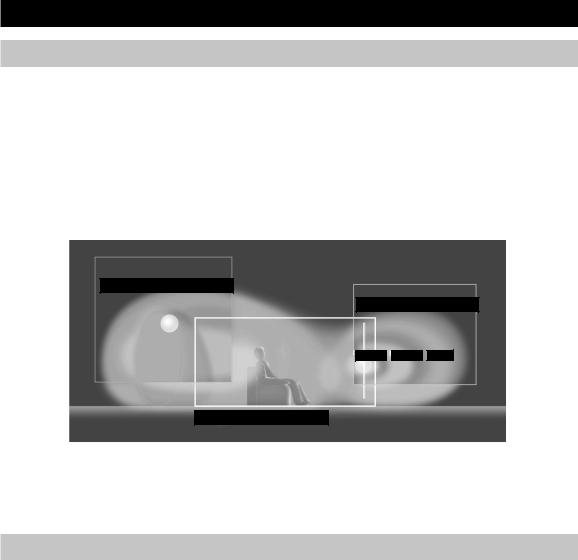
CINEMA-DSP
Sound design of CINEMA-DSP
Filmmakers intend for the dialog to be located right on the screen, the effect sound a little farther back, the music spread even farther back, and the surround sound around the listener. Of course, all of these sounds must be synchronized with the images on the screen.
CINEMA-DSP is an upgraded version of YAMAHA DSP specially designed for movie soundtracks. CINEMA-DSP integrates the DTS, Dolby Digital, and Dolby Pro Logic surround sound technologies with YAMAHA DSP sound field programs to provide a surround sound field. It recreates comprehensive movie sound design in your audio room. In CINEMA-DSP sound field programs, YAMAHA’s exclusive DSP processing is added to the Main left and right, and Center channels, so the listener can enjoy realistic dialogue, depth of sound, smooth transition between sound sources, and a surround sound field that goes beyond the screen.
When a DTS or Dolby Digital signal is detected, the CINEMA-DSP sound field processor automatically chooses the most suitable sound field program for that signal.
L SURROUND SOUND FIELD
PRESENCE SOUND FIELD
DIALOG 
 EFFECT
EFFECT 
 MUSIC
MUSIC
R SURROUND SOUND FIELD
In addition to the DSP, this unit is equipped with a variety of precise decoders; Dolby Pro Logic decoder for Dolby Surround sources, Dolby Pro Logic II decoder for Dolby Surround and 2-channel sources, Dolby Digital/DTS decoder for multi-channel sources and Dolby Digital + Matrix 6.1 or DTS + Matrix 6.1 decoder for adding a rear center channel (the rear center channel is outputted from virtual rear center speaker). You can select CINEMA-DSP programs to optimize these decoders and the DSP sound patterns depending on the input source.
CINEMA-DSP Programs
The following list gives you a brief description of the sound fields produced by each of the DSP programs. Keep in mind that most of these are precise digital recreations of actual acoustic environments. Select the DSP program that you feel sounds best regardless of the name and description given for it below.
■ For audio-video sources: No. 4 to 6
No. |
Program |
Features |
|
|
|
4 |
ENTERTAINMENT/ |
This program adds a deep and spatial feeling to video game sounds. |
|
Game |
|
|
|
|
5 |
MUSIC VIDEO |
This program lends an enthusiastic atmosphere to the sound, giving you the feeling you are at an |
|
|
actual jazz or rock concert. |
|
|
|
6 |
TV THEATER/ |
This program is provided for reproducing monaural video sources (such as old movies). The |
|
Mono Movie |
program produces the optimum reverberation to create sound depth using only the presence sound |
|
|
field. |
|
|
|
|
TV THEATER/Variety/ |
Though the presence sound field is relatively narrow, the surround sound field employs the sound |
|
Sports |
environment of a large concert hall. This effect enhances the experience of watching various TV |
|
|
programs such as news, variety shows, music programs or sports programs. |
|
|
|
28
